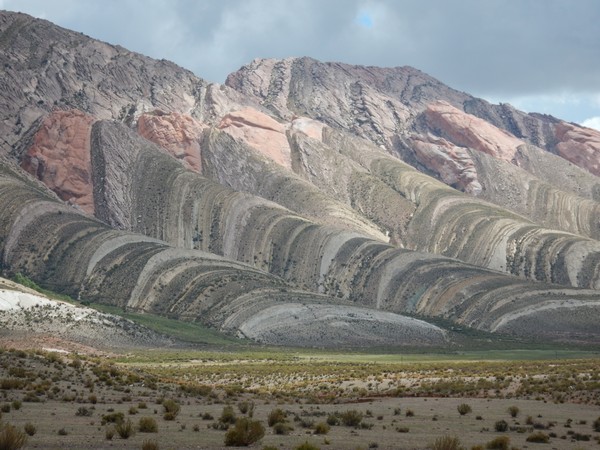
Bare landscapes, fiestas, fierce winds, Gaucho’s, mummified children and the art of Asado would mark my introduction to cycling in Argentina as I cycled through the Puna – one of the remotest environments on the planet that consists of an interconnected system of volcanic cones and giant lava outcrops.
My Argentinian adventures started in the border town of La Quiaca (also known as Villazon on the Bolivian side of the border). I had crossed the border the previous evening and had a few jobs to do before setting off to continue my route south through some of the harshest landscape that I had so far cycled through.
Puna is a Quechua word, the language of people of the central Andes of South America, meaning “a cold and remote place difficult to live in”. In mountain areas the flora and fauna of an area are predominantly determined by elevation. Where the Altiplano is the area of the Andes above 3500 m the Puna encompasses diverse ecosystems of the high Central Andes between about 3200 and 3500 m.
The Puna, whose elevation was once again above the treeline, extends from central Peru in the north, across the lower Altiplano of Bolivia south along the spine of the Andes mountains into northern Argentina and Chile.
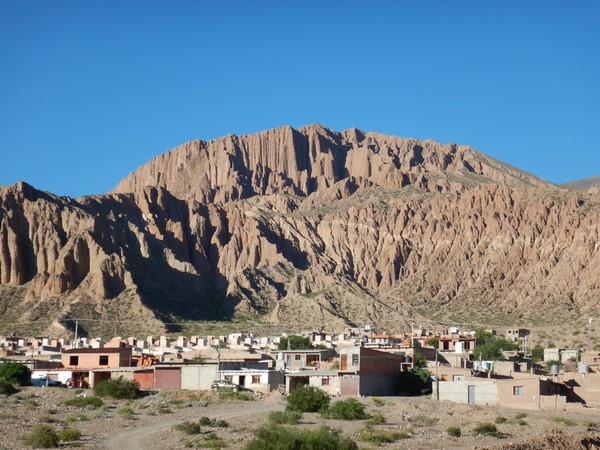
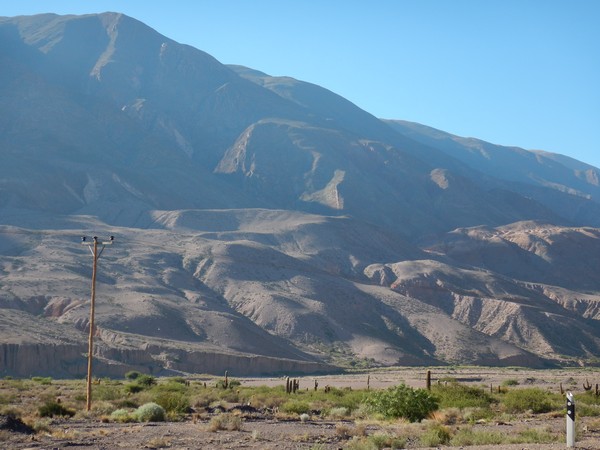
The first job I needed to do before I set of was to get connectivity and so I set off in search of a phone shop to buy a new SIM card. In Bolivia you need to register with the mobile network by providing a copy of your passport and details of where you live etc. In Argentina, the process was much simpler and there was no need to register.
However, what I discovered was that non-nationals are limited to only being allowed 50mb of data per day with no option of buying more. In other words, once your 50mb had been used you would need to wait until the following day for your allocation to reset.
The only work around that was available was to buy and load money onto multiple SIM cards and so, again to improve my chances of connectivity, I bought a SIM card for all 3 of the phone networks that operate in Argentina – Movistar, Claro and Personal. Each of the 3 companies seem to concentrate their coverage on different areas of Argentina and everybody told me that Personal had the best coverage for cycling the puna.
What I would discover as I set off south though was that despite having a SIM card for all of the phone companies for the next 500km I would have no phone coverage at all !!!!!
By the time that I had finished getting the SIM cards sorted it was gone 11am and I still had one more job to do which was to change the small amount of Bolivian currency to Argentinian pesos. Instead of heading to the bank I just cycled to the bus station as I could guarantee that there would be somebody there who would change my money.
As I cycled into the bus station I was immediately approached by a man saying cambio, exchange, and as he was offering a slightly better rate than the official bank rate I needed to look no further and changed my currency with him.
I also changed a few hundred US dollars that I carry as cash with me so that I had enough money to last for the next week or so as where I was heading I knew that there would be little chance of finding an ATM.
The other thing that is weird in Argentina, as I found out when I landed in Buenos Aires, is that all of the cash machines charge you 100 pesos (around 5 GBP) per transaction to take out money. As the most that I can take out in one go is 2000 pesos this 5% charge is fairly hefty and so it is far cheaper just to bring dollars and change them on the black market.
As it was now nearly lunchtime I decided that as I was still in La Quiaca that I would eat before heading off south. If I had been in Bolivia I would have cycled around trying to finad a place which served Almuerzo (set lunch) but now that I was in Argentina there was no need as everywhere around town the beautiful aroma of meat cooking on barbecues could be smelt.
It seems that in Argentina many people make a living by selling food from a barbecue and I kid you not that by midday there must have been at least 50 people around town offering food from their makeshift stalls by the side of the road.
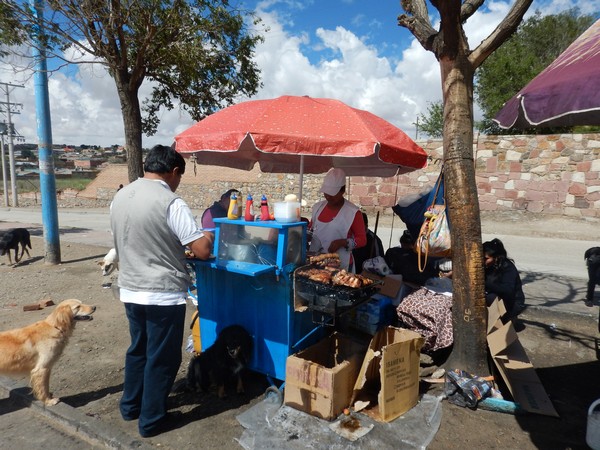
I was in meat heaven and it was 40 pesos (2 GBP) for a big plate of meet served with pasta and salad.
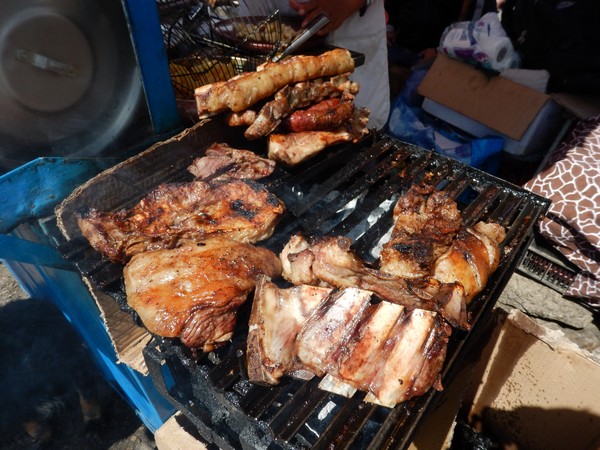
In Argentina, a barbecue or “Asado” is not just a way of cooking meat; it is an art form. Every chef has his own personal secret when it comes to arming the parrilla (grill), whether it is the heat of the fire, the ratio of coal to wood, or at what moment they turn the meat over. I was fast discovering that grilled meat is part of the Argentine national identity. (A guide to Argentine Asado)
After eating what was probably the biggest portion of food that I had had in a while it was time to start pedaling south. When I cycle tend to have a planned destination in mind which is normally a week away and once I get there I plan the next ‘mini’ leg. My destination for this section of the ride was the city of Salta which lay with the route I was taking about 500km away.
In my favour though was that I was heading toward the lowlands and out of the mountains which should make the first couple of days riding pretty fast as gravity would be on my side.
The landscape that I was cycling through was bereft of any vegetation and the mountains on either side of me were bare rock. Living here sure must be a very harsh existence.
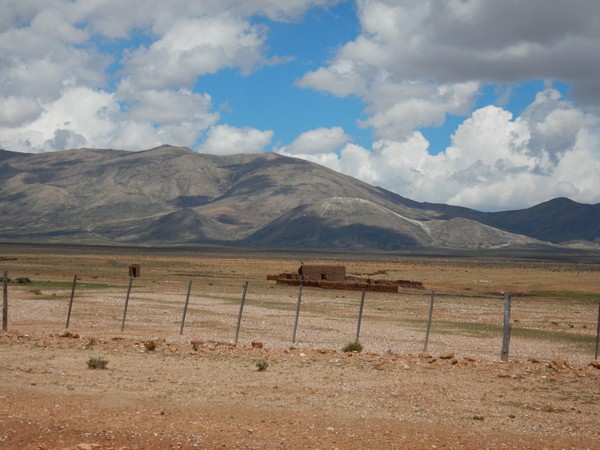
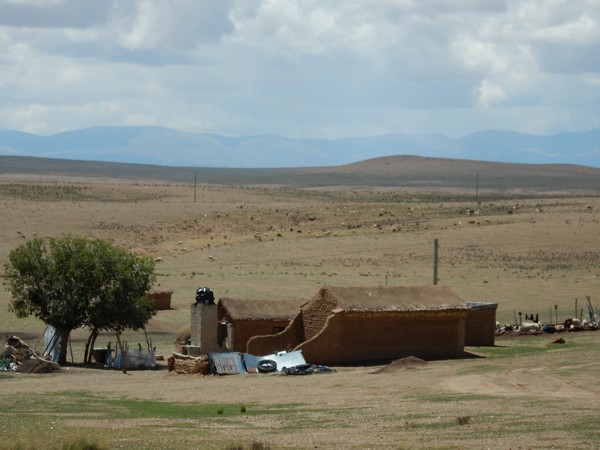
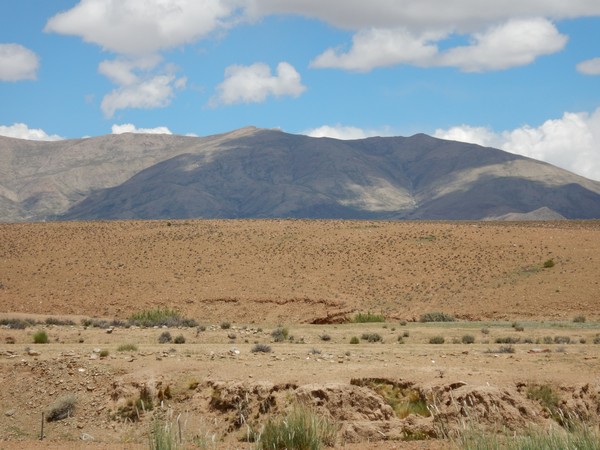
The other thing that hit me like a wall was the wind. Even though I had gravity on my side making forward progress was at times nearly impossible. The area is known for strong winds known as the Zonda which is produced by the northeastward movement of polar fronts where at high altitudes the wind speeds sometimes reach over 200 km/h. The Zonda wind most commonly starts during the early afternoon tends to blow between 1 and 12 hours, though it may present itself intermittently for as long as 2 or 3 days.
The winds that I encountered in the afternoon as I cycled my way south through north western Argentina would at times be that strong that the only way to make forward progress would be to get off and push the bike. This included some DOWNHILL sections where even gravity could not overcome the force of the wind.
After only 10km I contemplated just turning around and heading back to La Quiaca and starting again in the morning but pushed on hoping that the winds would give me a break.
Argentina is one hour ahead of Bolivia which meant that I would have an extra hour of daylight at the end of the day so despite not setting off until after midday I could potentially cycle on until 8.30pm so had set myself a target of covering 100km before I set up camp for the night.
Looking on the map there was a town of Abra Pampa at around 70km and given the state of the winds this may well be where I ended up for the night. Still, at least I had a tarmac road under my wheel and gravity in my favour which made the cycling much easier and I was able to roll along at between 10 and 15kmph for most of the day.
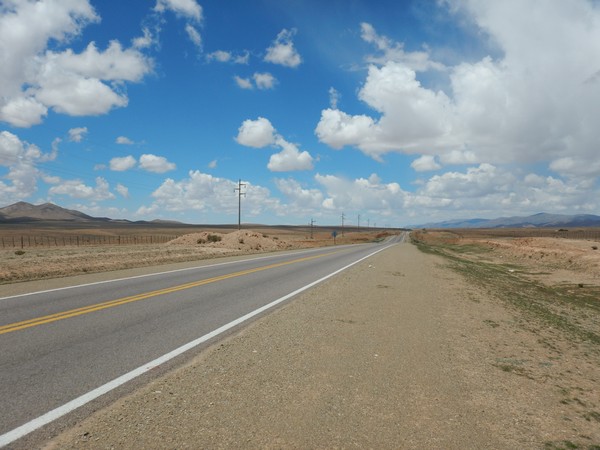
Even though I had only been cycling in Argentina for a couple of hours there were notable differences between here and Bolivia. The first major difference was how people drive. Think of the a scene from the car movie ‘The Fast and the Furious’ when they are about to pull a heist and drive their cars in ‘formation’ literally with just an inch separating their bumpers. Well this is how drivers in Argentina tend to drive – a truck or coach will come down the road with a convoy of cars sitting behind it, seemingly using it as a wind block, separated by the width of a cigarette paper.
The other major difference that I continually see next to the road side are the ‘shrines’ that people have built to honour their relatives. In Bolivia these tended to be about a foot high and had a cross on them. Here in Argentina they were more ornate buildings with sun shades erected over them.
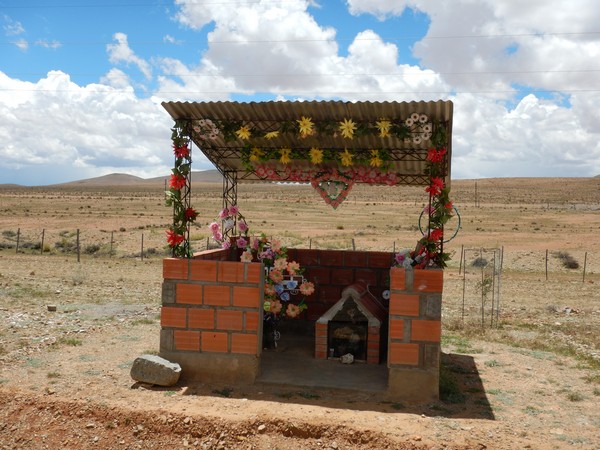
In keeping with the barbecue theme I passed a few where families were honouring the anniversary of their loved ones passing by having an Asado at the shrines.
Although I was passing no villages whenever a side track joined the main road there were concrete bus shelters for people to use as they waited for the next bus to come down the road.
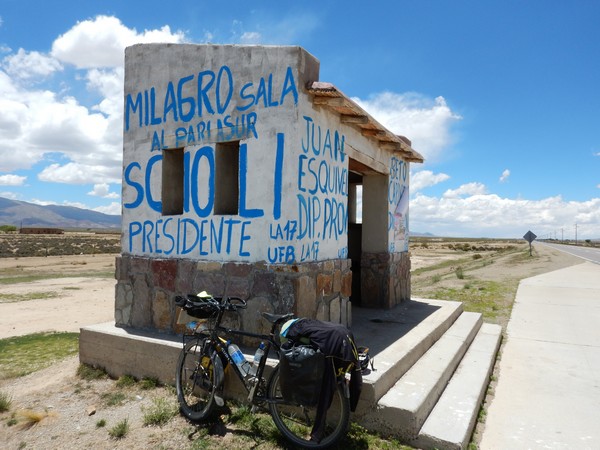
These also made an ideal wind break in the late afternoon for a coffee stop once I had hit the 50km mark.
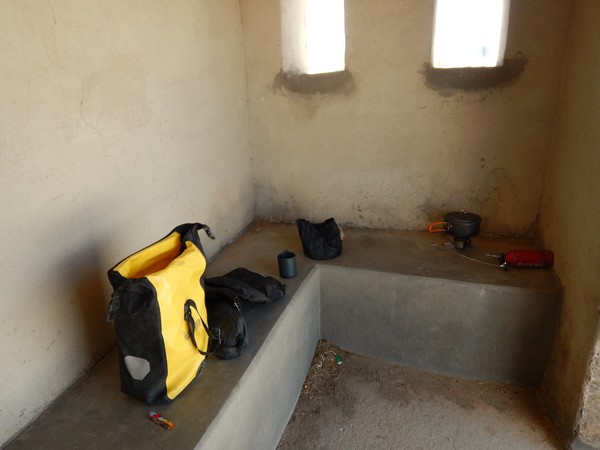
The other thing that I had found in La Quiaca was coffee in a bag – it looked like my daily caffine fix was now sorted.
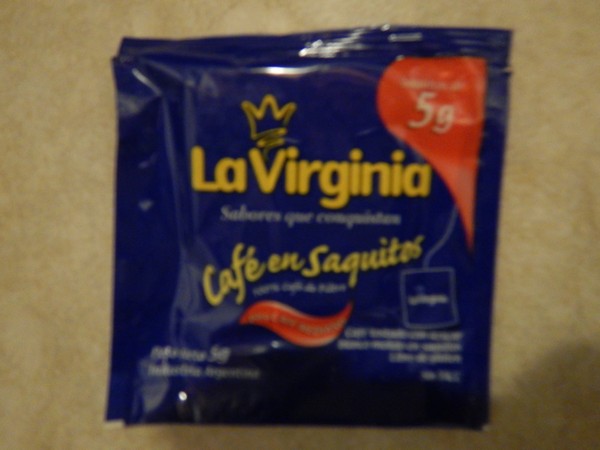
The only problem was that when I had brewed my first cup it wasn’t actually very nice – although it had the aroma of coffee it tasted like the bag had been used a few times before and was not flavoursome at all. A very disappointing first brew and I could see my search for a decent coffee bag in Argentina turning into a bit of an adventure in it’s own right.
After coffee the road headed out away from the mountain range that I was tracking into the middle of the valley and I was now following a dry river bed.
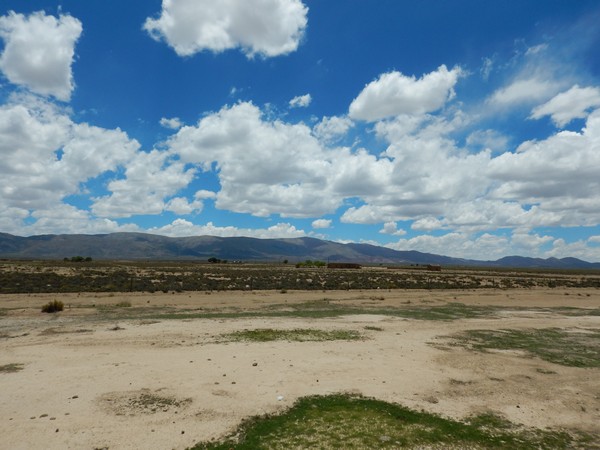
What little wind protection the mountain gave be was now stripped away and I was left to cycle into the full force of the wind. I still had over an hour of cycling until I reached the town of Abra Pampa where I had the option of stopping for the night if the incessant wind didn’t give me a break.
This section of the days cycle was probably the most tortuous and many times I nearly stopped and camped but I was determined to push on and grind out the last few kilometers to Abra Pampa where hopefully a nice fat juicy cake would give me the energy to carry on.
The other difference between Bolivia and Argentina that I was noticing was the amount of hitch hikers that there were. I must have passed at least 20 so far on my ride south from La Quiaca and each one I passed I would stop for a chat. Without fail, they were all Argentinian students who were now on holiday for their summer break (in the southern hemisphere the school/university holidays are January and February as opposed to the northern hemisphere holidays which are July and August). It seems that hitch hiking around Argentina is still seen as a ‘right of passage’ for many young Argentinians which was great to see.
When I had been in my late teens and early twenties I had done the same and used hitch hiking as my main form of transport across much of the world – UK, Europe, Australia, USA, North Africa, South America – and in a way it always makes me a little sad to drive back home in the UK and pass empty motorway junctions without a line of hitch hikers holding cardboard signs.
I reached Abra Pampa by late afternoon to find a very orderly and planned town in the middle of the Puna.
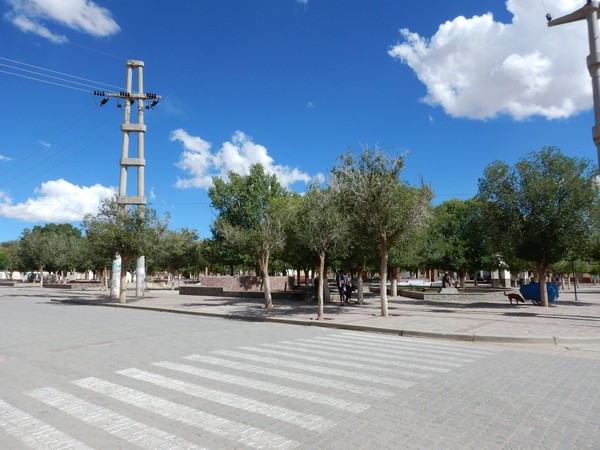
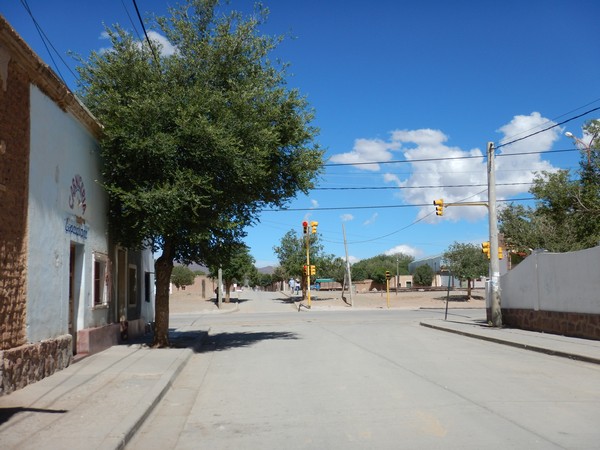
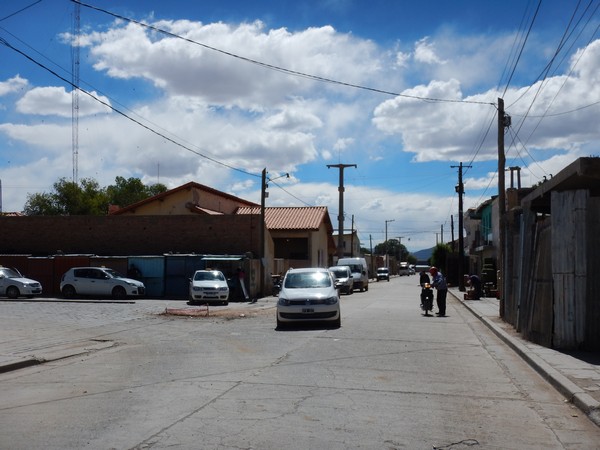
It seemed though that in Argentina the culture of the siesta was live and well as sll the shops were closed. This was a slight issue as I was now out of water and unlike in Bolivia where every village had a communal tap in Argentina I was back to either knocking on the door of a house or buying bottled water. At around 25 pesos ( over 1 GBP) for a 2 litre bottle this could prove expensive.
I asked somebody that I saw coming out of a house whether they could let me use their tap and they said that the water was not good for drinking. I assured them that I had a water filter and showed them my travel tap bottle (click here for more info) with it’s UV filter. I’m not sure whether the man understood my explanation but pointed to a tap in their front yard and told me to help myself.
On the road whilst cycling I have met other cyclists who still use what are known as ‘straws’ (click here for more info) to filter water. I’m not sure why people still travel with these as there are now 21st century options available, like UV filters which are good for around 1000 litres that have made these options redundant. Still, each to their own.
After another circuit of the town I found a supermarket which was open and went in search of coffee. It seemed like coffee culture in Argentina was alive and well and even in the small supermarket I found a few offerings of coffee bags. I asked the owner which one was good and she said that she hadn’t tried them but pointed me in the direction of La Morenita which she said was a well known brand.
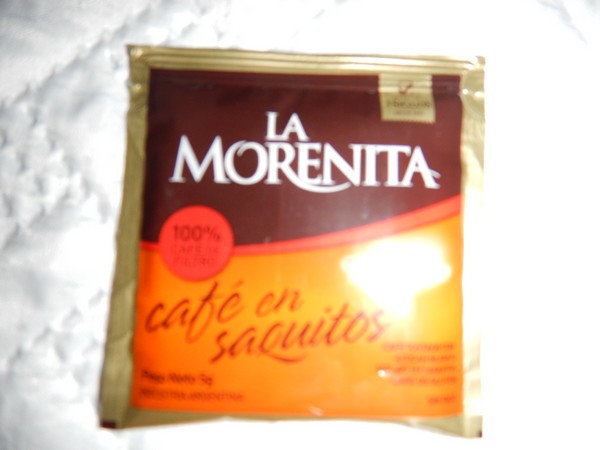
Only time would tell whether her choice was a good one and either way it couldn’t be much worse than the first brand that I had bought.
I now had a choice – to find somewhere to sleep in the town or to push on to my target of 100km for the day. The headwind that I had been battling all day was still whipping down the road but as it was only 5pm and I still had another 3 hours of daylight I decided to press on.as I figured that the extra 30 km would only take me another couple of hours.
Two and a half hours later I had only covered just over 20km at an average speed of less than 10kmph as the wind was killing me. I had now reached 92km and although I only needed another 8km to reach my target for the day I had had enough and started scanning the area to the side of the road to pull over to pitch my tent.
About 100m off to my left there was a group of Llamas next to the railway track which was running parallel to the main road
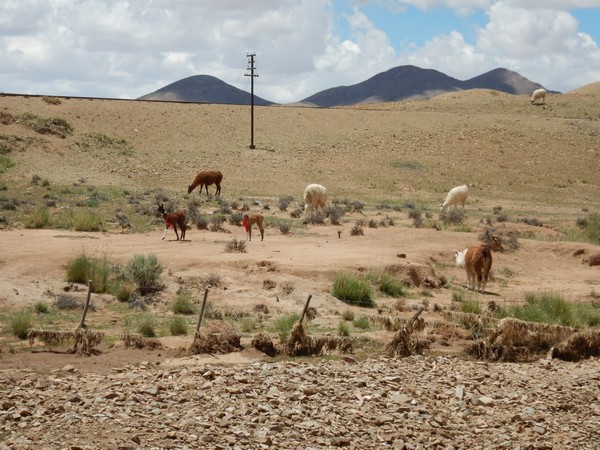
I could see that there was a ‘watering hole’ that they used and as it was nice and flat this would make an ideal place for me to pitch my tent so I left the road and cycled over to check it out. It turned out to be an ideal spot and so I set up camp for the night.
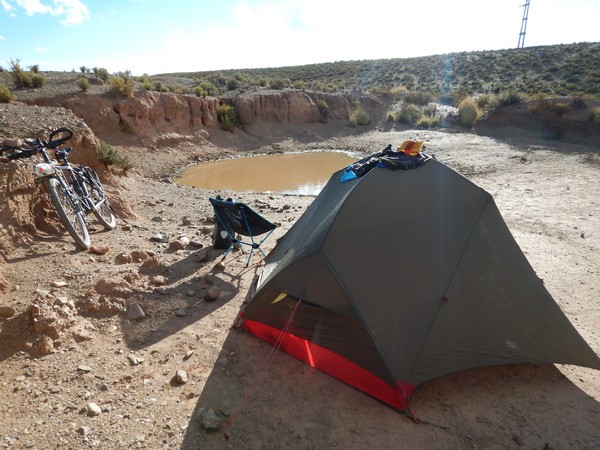
The night before I had bought myself a can of beer to celebrate leaving Bolivia but had not got around to drinking it so I set my chair up and enjoyed the beer while watching the ‘fireworks show’ that was the electrical storm that was developing back up the head of the valley that I had spent all day cycling down.
Over night there had been heavy rain and in the morning although it was dry the rain clouds had not cleared and when I set off I expected to get wet at some point during the day
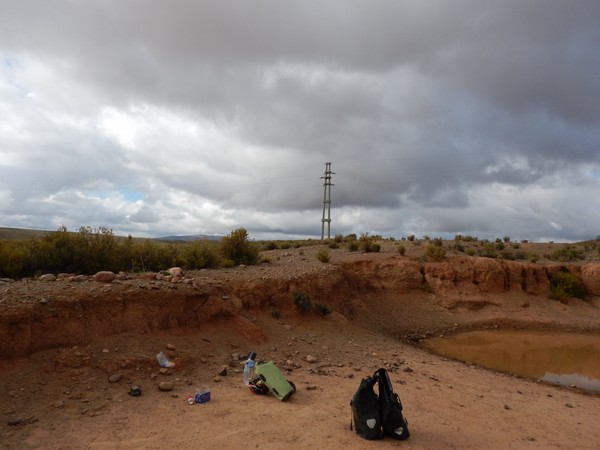 Like in the Altiplano the weather systems of the Puna seem to be slow moving and like a scene out of the movie ‘The Adams Family’ (lots of movie references in this post !!!!) I seemed to be cycling under a big black cloud. All around me I could patches of sunshine but I seemed to be constantly cycling in the shadow of the cloud which made the morning cycle very chilly.
Like in the Altiplano the weather systems of the Puna seem to be slow moving and like a scene out of the movie ‘The Adams Family’ (lots of movie references in this post !!!!) I seemed to be cycling under a big black cloud. All around me I could patches of sunshine but I seemed to be constantly cycling in the shadow of the cloud which made the morning cycle very chilly.
I even contemplated stopping for 30 minutes to have another delicious coffee (the new coffee bags were a winner) in the hope that the cloud would move ahead of me.
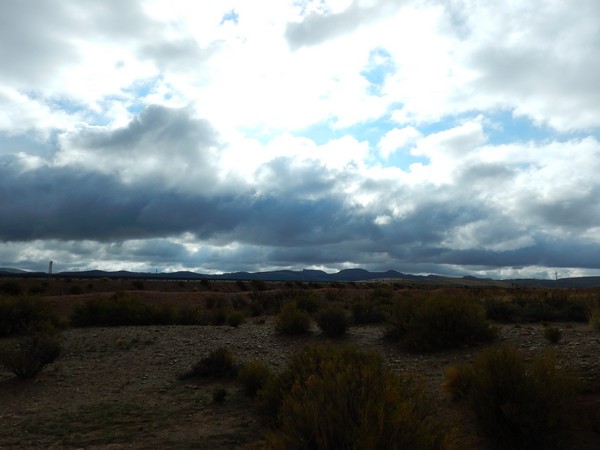
The first couple of hours saw me having to climb my way out of the valley that I had been cycling through for the whole of the day before and I was back at nearly 4000 m by the time that I had reached the summit of the pass.
The uplifted volcanic rock strata of the mountains that I was cycling through were very dramatic as the different mineral layers were clearly visible and made for a stunning backdrop
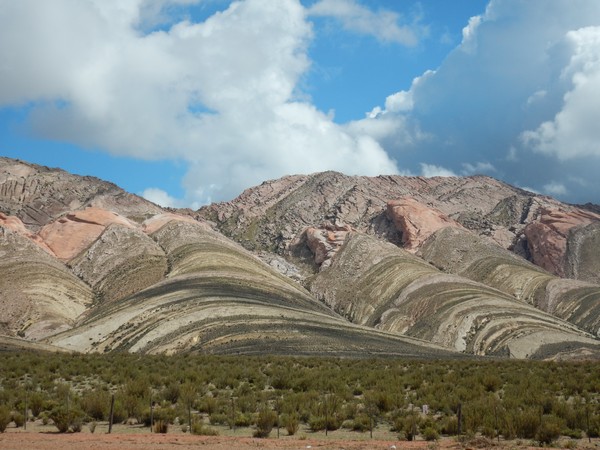
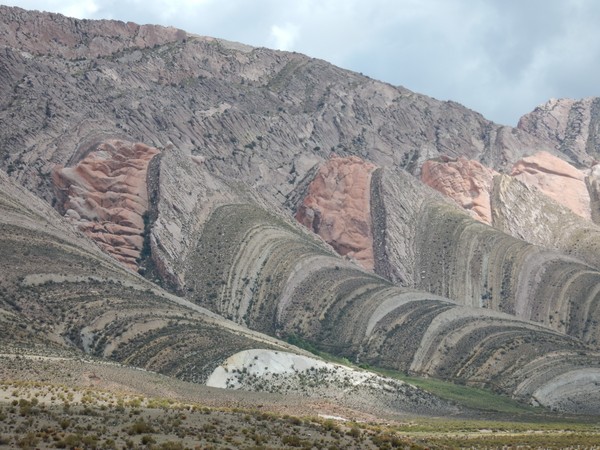
This section of the road was unpaved but like the Tupiza road in Bolivia would soon be sealed as all along the road construction workers were busy at work
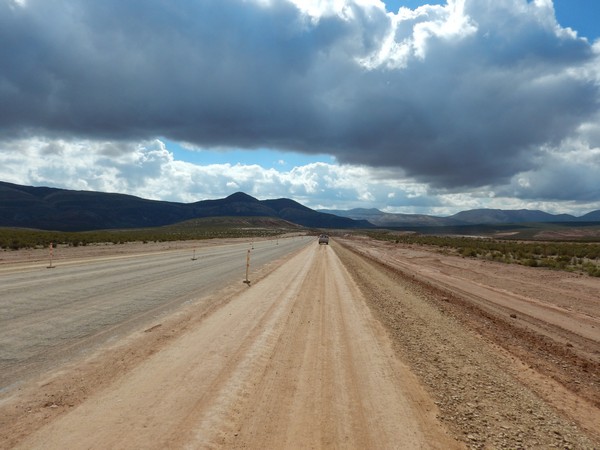
The wind that morning had been with me but at midday it was like somebody flicked a switch on a huge wind machine and I was once again batting a gale of a headwind. I would definitely have to start changing the way that I cycled and instead of my normal 10am start and late finish I would need to make sure that I was on the road by 7am and finishing around lunchtime/ early afternoon.
Over the top of the next rise I saw what I thought was another toll station but it turned out to be a document check where I had to pull over and show the police my identification.
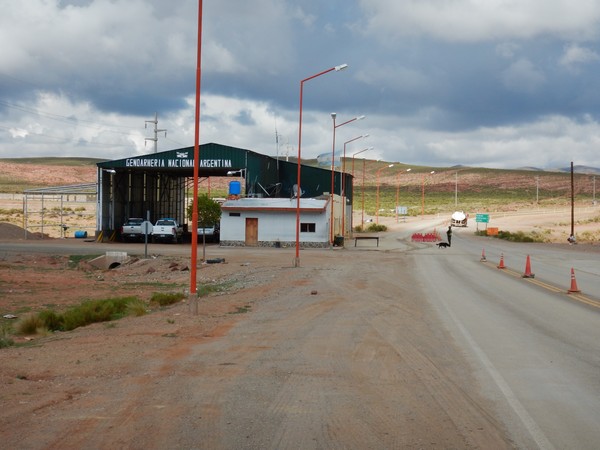
Every other vehicle that was travelling down the road was also pulled over with people having to dismount and the vehicles searched. This would become a regular feature of my day with having to pass through regular police checks at least three or four times a day. Normally they would just wave me through but all vehicles would have to pull over and produce their documents.
Even in the towns that I passed through their seemed to be a huge police and military presence with ‘patrols’ walking around in pairs or standing around in groups.
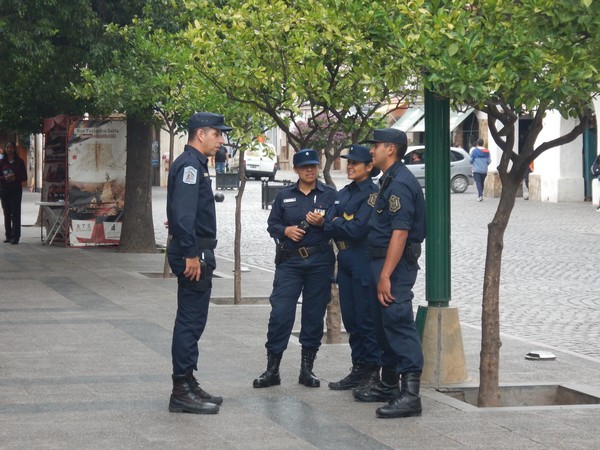
By the time I had reached the village of Azul Pampa I had covered nearly 50km and pulled over at a shop to get a snack.
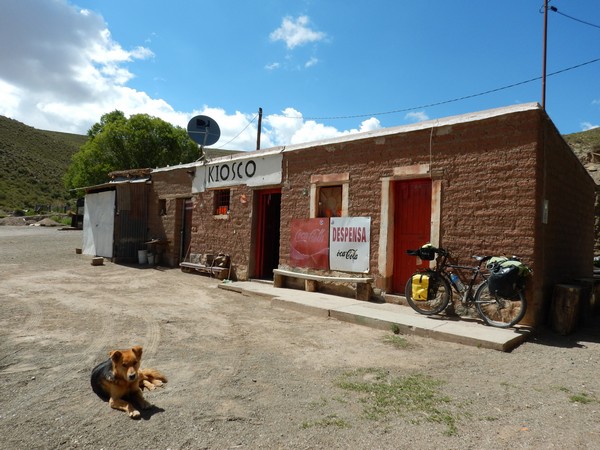
The shop seemed to only sell coke and fanta and biscuits so I chose a pack of galletitas dulce, sweet cookies, that cost me 14 pesos and were fantastic; one of those snacks where you have one and then just keep snacking on them until they are all gone.
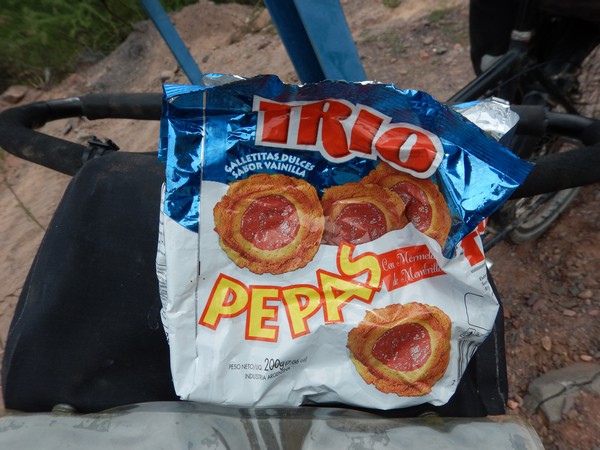
My aim for the day was once again to try and hit the 100km mark which would by nightfall see me arrive at the town of Tilcara and if I made it to there I would spend a couple of nights as from what I had been told by some of the hitch hikers that I had talked to the town was a very popular stop off on the road to Salta and had a great café culture with live music in the main plaza most nights. It also apparently had connectivity which was important as I my father was having his heart operation in the next couple of days and I wanted to check that everything had gone to plan.
Thankfully, I reached the point in the mountains where gradually over the next 200km or so I should start descending my way off the Puna and down into the lowlands. I was looking forward to getting out of the crazy winds and cycling at a far more reasonable elevation of around 4500ft rather than the 11000 ft that I was currently cycling at.
It was now nearly midday though and just like yesterday the wind started to blow and it just got stronger and stronger and almost impossible for me to make any forward headway especially as the road, railway and river all squeezed themselves into a very narrow valley that twisted its way through the mountains.
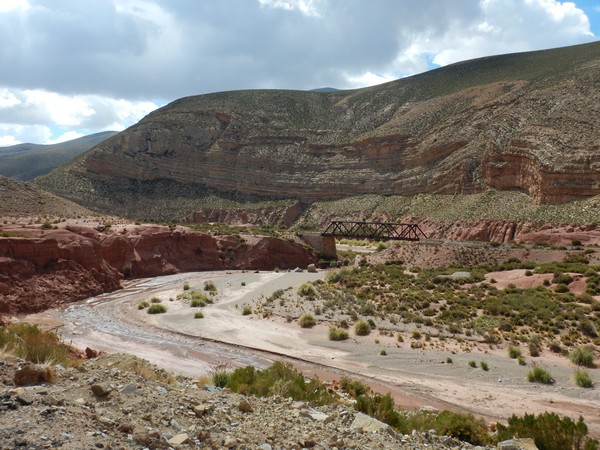
This just seemed to concentrate and turbo charge the wind so that I even had to get off and push my bike for not only some of the uphill sections but the downhill ones too.
My first Argentinian cyclists passed me and even though they were going uphill at the time with the the wind behind them I swear they were going faster than I was even though I was heading down a hill at the time.
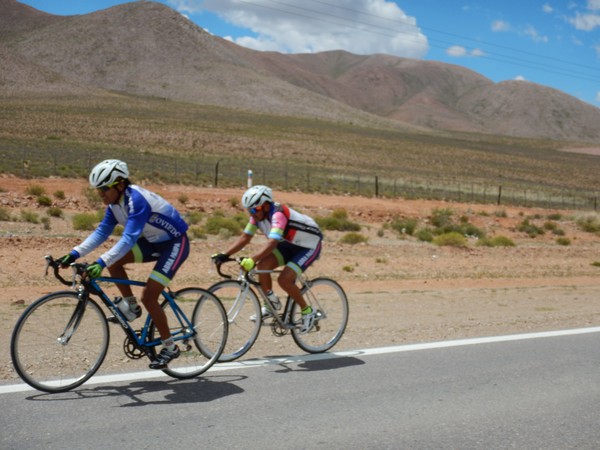
I was tempted to stop for lunch but knew that 10km up ahead was the town of Humahuaca that given the layout of the roads on google map offered me better pickings than soup with pasta which had become my staple lunch that I was now making on the road since my beloved pot noodles had gotten exhorbinatly expensive here in South America.
At just before 2pm I rolled into the town to find a full blown fiesta going on with marching bands, processions, street vendors and lots and lots of barbecues.
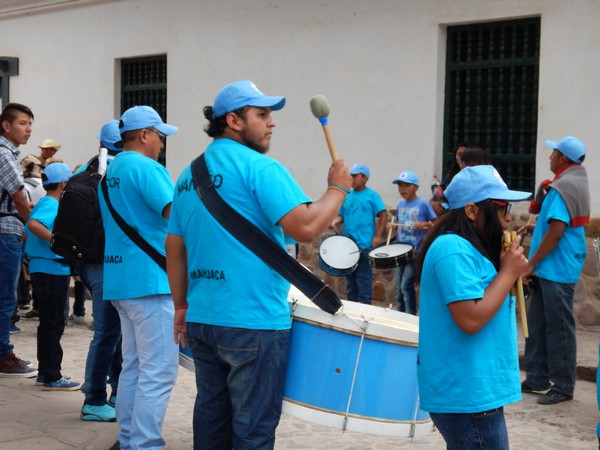
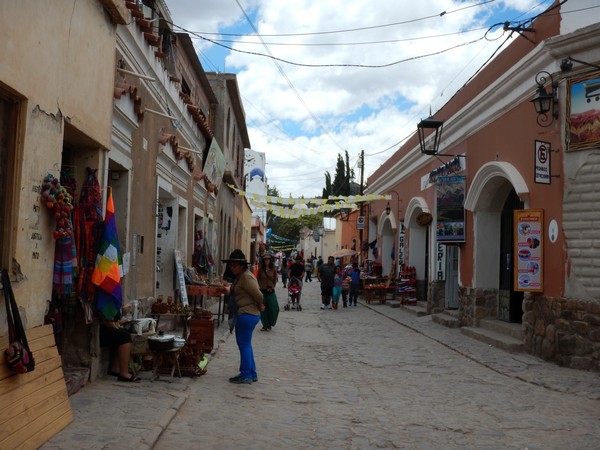
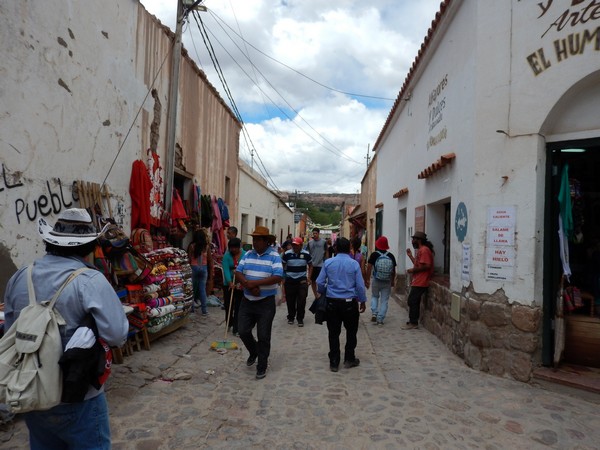
I asked one of the locals what the occasion was and he said that the fiesta was to honor the Virgen de la Candelaria or Virgin Mary. He said that all day there would be bands and processions through the street of the town and then in the early evening a gaucho parade (think Argentinian cowboys on horseback wearing traditional clothing) and an evening mass at the church to celebrate the Virgin Mary.
I joined the locals at one of the barbecues and had another huge plate of meat before leaving my bike with the owner of the barbecue and wandering around town to soak up the atmosphere.
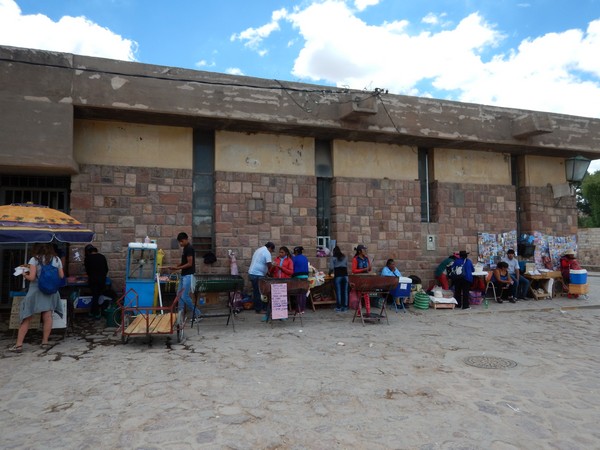
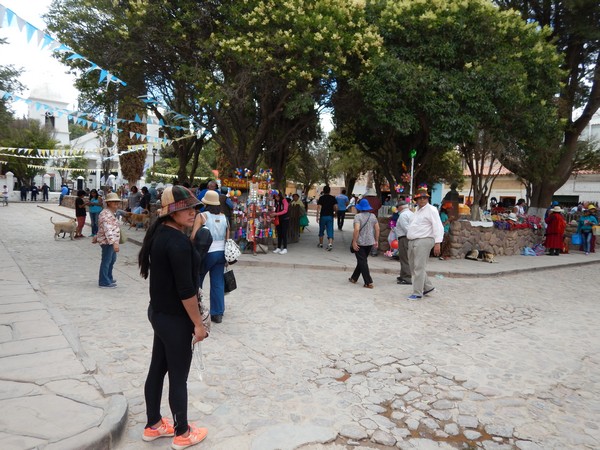
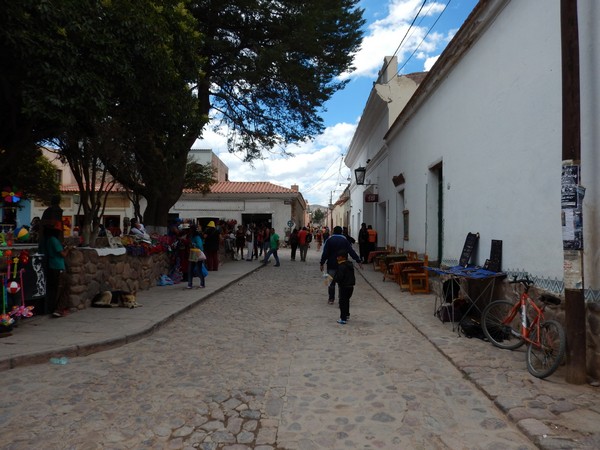
It was a great place to spend the afternoon and around 3pm the main procession started to make it’s way through the town.
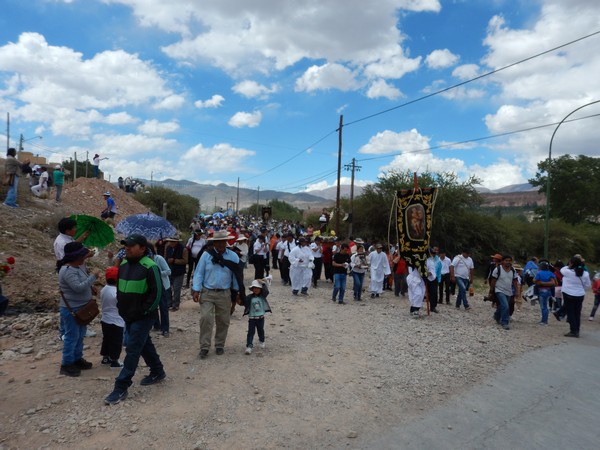
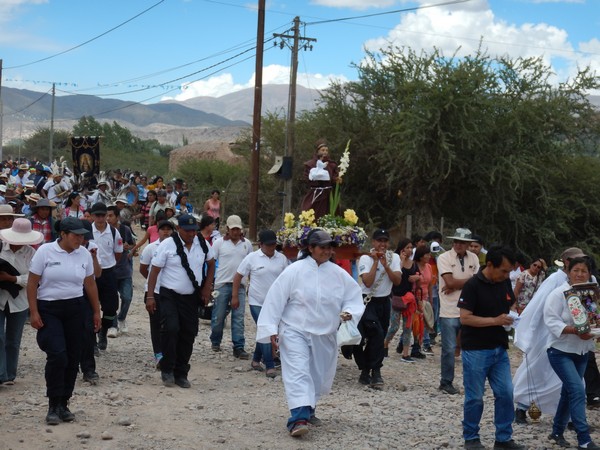
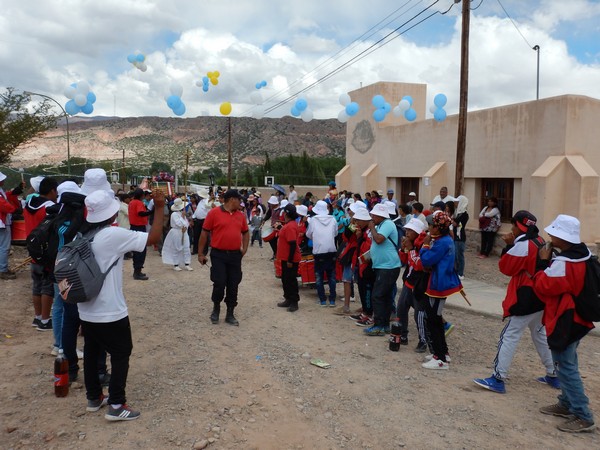
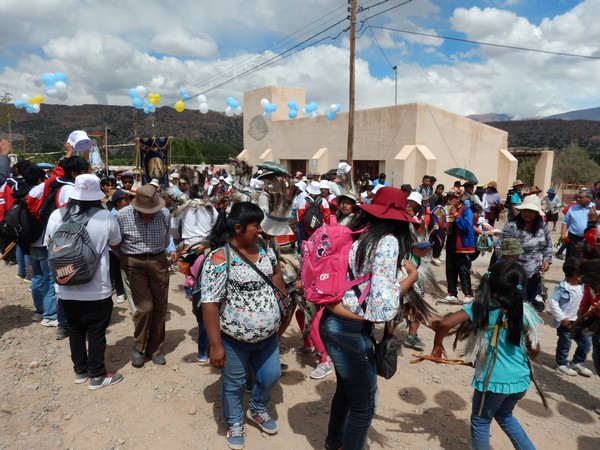
Here is a short video to give you some idea of the noise and beauty of the parade that was unfolding in front of me.
I would have loved to have stayed in the town overnight but I needed to find a reliable internet connection for my skype interview the following morning and people told me that I should continue to Tilcara which lay another 30 km down the road.
With a heavy heart I set off, not because I was missing the parade but because the wind seemed to have even more strength than when I had arrived. Even though I was heading downhill for most of the next 30km for most of it I was not even able to get above 10kmph but I still had daylight and so I was determined to get there rather than camping next to the river that I was following and cycling onto Tilcara early the next morning.
Just outside the town of I crossed another invisible landmark – the Tropic of Capricorn
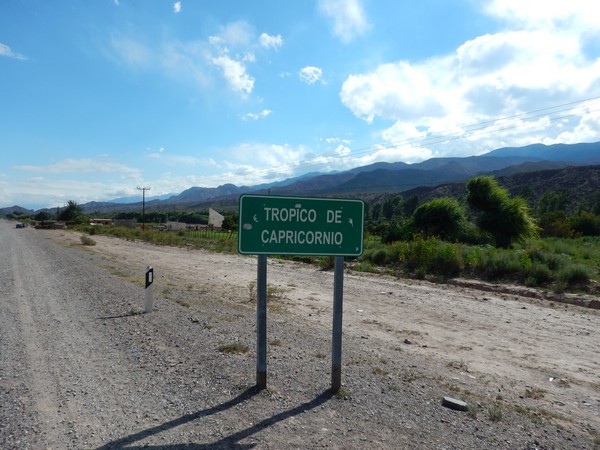
The tropic of Capricorn represents the southernmost latitude where given the seasonal tilt of the earth that the sun can be directly overhead (The northern hemisphere equivalent is the Tropic of Cancer) and is apparently named because 2000 years ago the sun was entering the constellation Capricornus on the December Solstice.
The word tropic is derived from the Greek tropos which means turn. This refers to the fact that the sun appears to ‘turn back’ at the solstices as the earth begins to once again tilt in the other direction. After a few minutes of contemplation, or more like a respite from the incessant wind I was once again heading south to finish my trek to Tilcara.
I was now looking for any distraction to break the wind and on the horizon I could see a giant Llama and so pulled in when I passed the place to take a look.
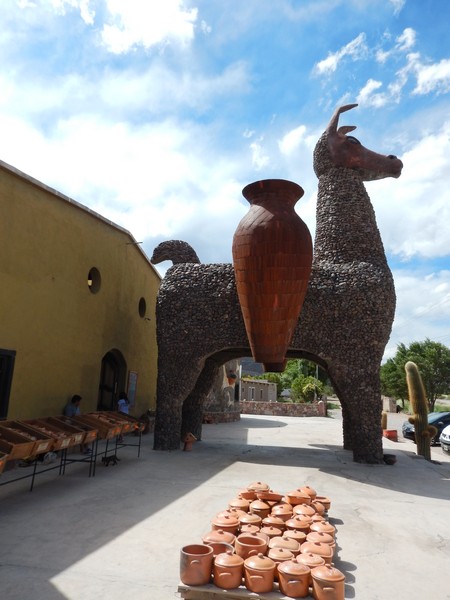
The llama turned out to be the focal point for an Artesanal, which was like a kind of warehouse which sold handicrafts, mainly pottery, that locals in the area seemed to have made. Again, these seemed to be a popular stop for drivers on the sides of roads the further south I cycled.
It had taken me over 3 hours to complete the 30 km downhill ride from Humahuaca to Tilcara but I finally saw the sign which meant that my pain was soon to be over.
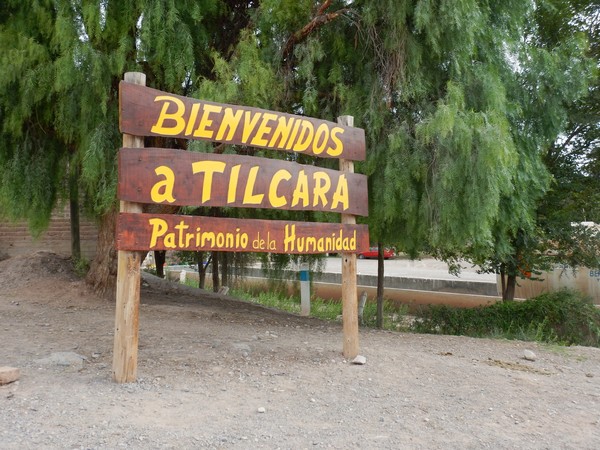
As I cycled into the town I passed a campsite and inquired how much it was
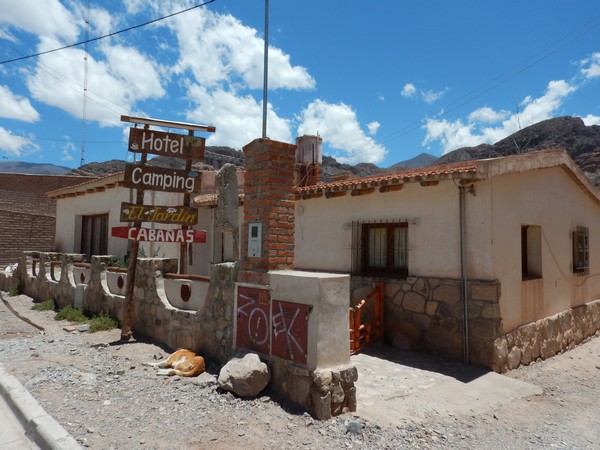
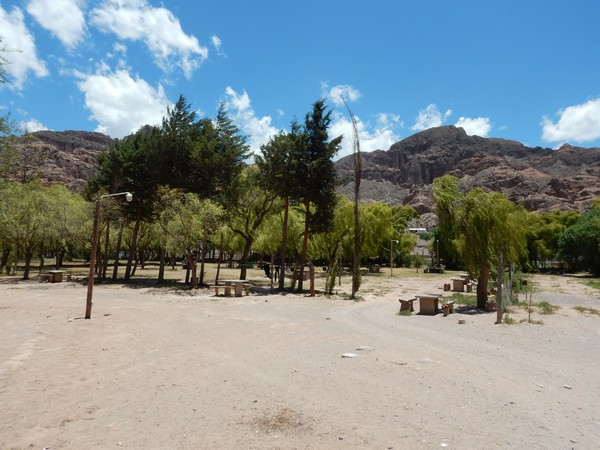
The guy on the gate said 80 pesos and they had hot water showers. Although the place looked relatively empty, and there was no booming music coming from car stereos, I fancied paying for somewhere with walls especially as I was planning on staying around for a couple of days.
I inquired at a few places before deciding to stay at the a hosteleria which was just off the main plaza in the centre of the town.
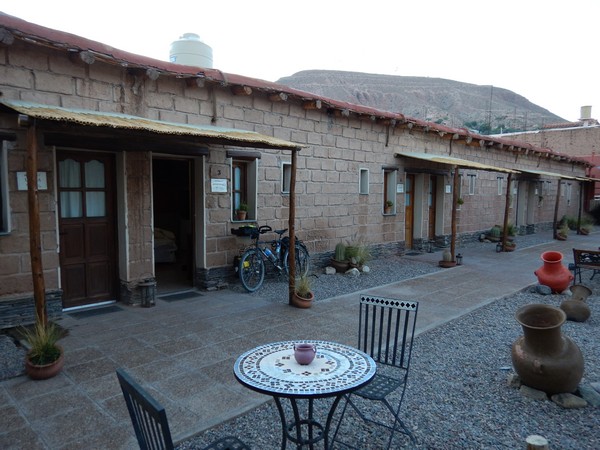
It was too late to phone the Uk due to the time difference so once I was showered I headed into town to get some food and ended up at a local eatery. I was tired and couldn’t be bothered reading the menu so just asked the owner to bring me whatever she thought was a typical dish from Tilcara/Argentina.
What she brought me was a dish called Locro which turned out to a yellow thick corn and bean stew with chorizo. It was served with bread and tasted delicious. As I was now in the province of Salta I washed it down with a beer of the same name.
The next morning I phoned home and it seemed that the operation had been a success and that he was now recovering and should be released in a week or so which was great news.
Tilcara turned out to be as beautiful a place as everybody had told me it was with cobbled streets, lots of historic buildings and a great café and restaurant culture.

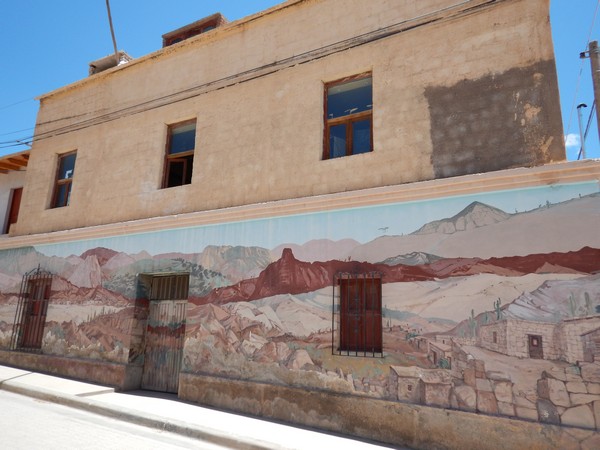
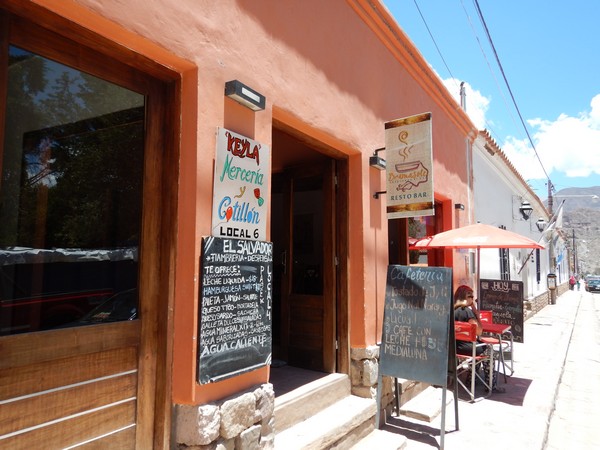
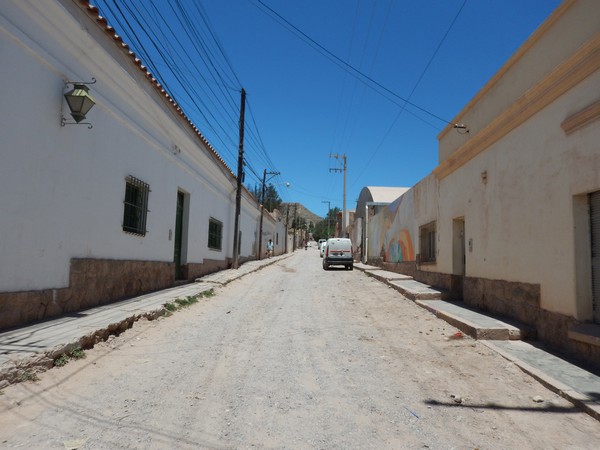
There seemed to be a lot of young Argentinian students who had taken up residence for their summer vacation and seemed to be making a living from baking goods in the kitchens of the hostels they were staying and then selling them out of Tupperware boxes along the pavements of Tilcara.
I also had found my new Argentinian snack – Tortilla de Parilla – which is a 12 inch bread tortilla that is spread with ham, cheese and onion and then folded in half before being grilled on a barbecue until crispy.
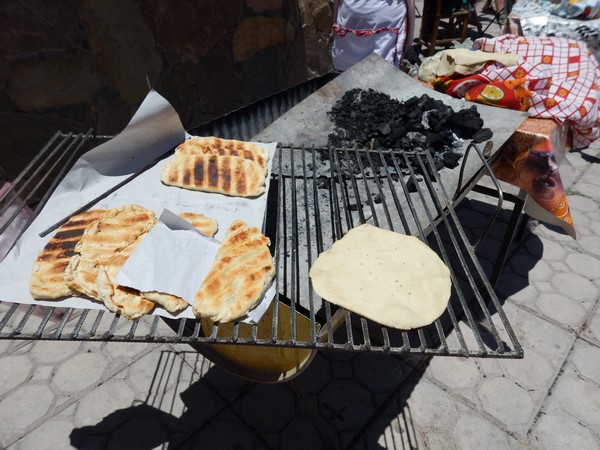
For the next two days I didn’t do very much except wander around town, drink coffee, have a few glasses of wine and eat great food. My favourite café was one which was part deli, part bar and part library and had a great atmosphere.
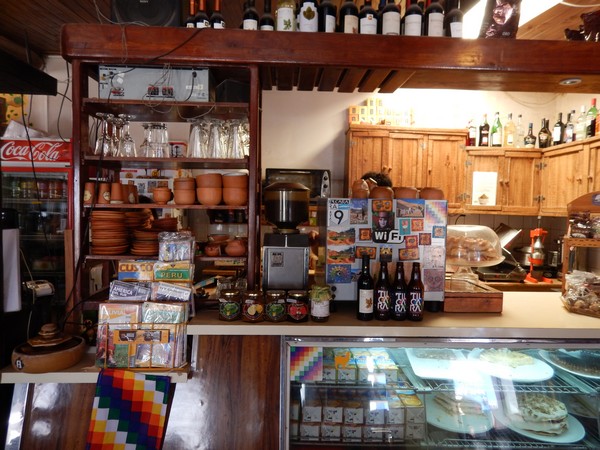
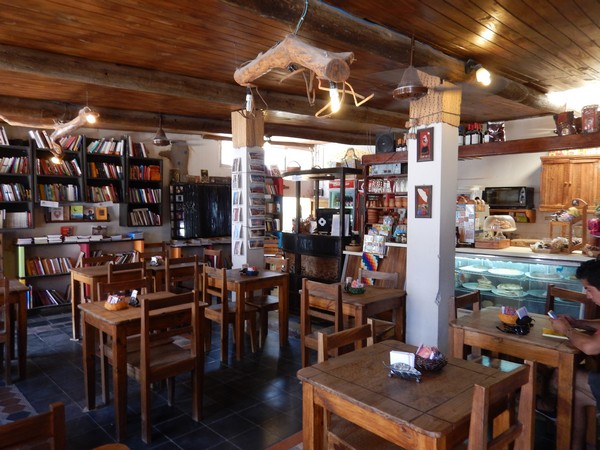
On my final night in Tilcara I treated myself to a nice meal. For the starter I had Carpaccio de Llama
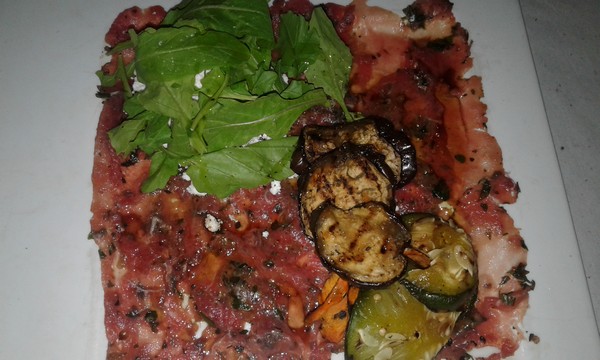
followed by Bife de Chorizo y Salteadas con papas andinas y cebollas (steak with blood sausage served with fried potatoes and onion) washed down with a couple of mini bottles of Argentinian bubbles.
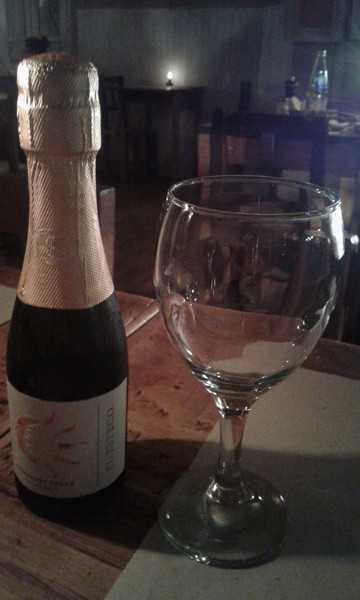
A great way to end a couple of fabulous days in Tilcara.
The next morning I wanted to get on the road early so that I could get most of my cycling done by the early afternoon and so avoid the severe winds which seemed to start blowing across the puna around midday.
By 7am I was up, showered and on the road heading south. When I had cycled into Tilcara 3 days earlier I was struggling to even break the 10kmph mark but now that there was no wind I was rolling along at over 20kmph and enjoying watching the stunning scenery roll by.
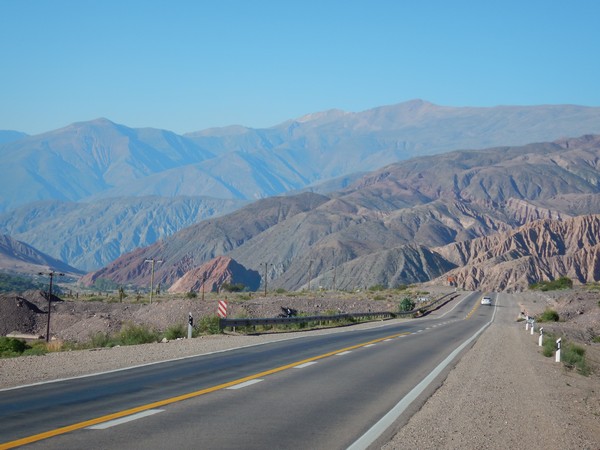
My next destination was Salta which was the capital of the province which lay around 200 km away. If the winds were kind it should take me two days to get there but if they were against me three.
It is amazing how much easier cycling on fresh legs is and at the first 50km fly by. Getting to 70 or 80 km takes a bit of work and the last 20km to get over the 100km mark is normally a struggle.
As I cycled south the bare rock mountains of the puna was among some of the most breath taking scenery that I had ridden through

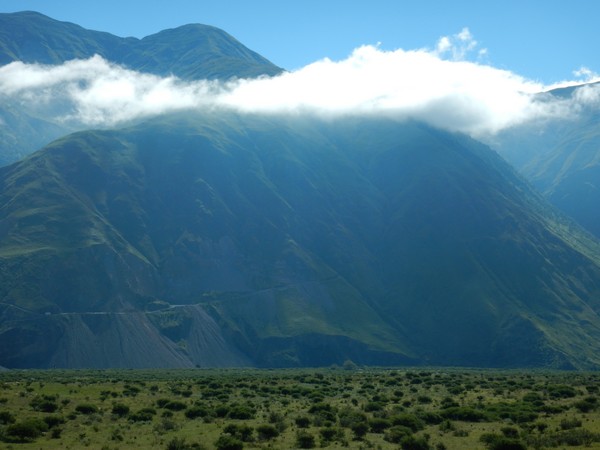 It really was a beautiful valley to cycle through and I was just glad that I was following a river rather than having to climb over the top of the peaks as they were huge.
It really was a beautiful valley to cycle through and I was just glad that I was following a river rather than having to climb over the top of the peaks as they were huge.
The other snack food that I saw being sold everywhere by the side of the road was empanadas (think mini cornish pasties) and come in 3 main varieties – beef, chicken or ham and cheese.
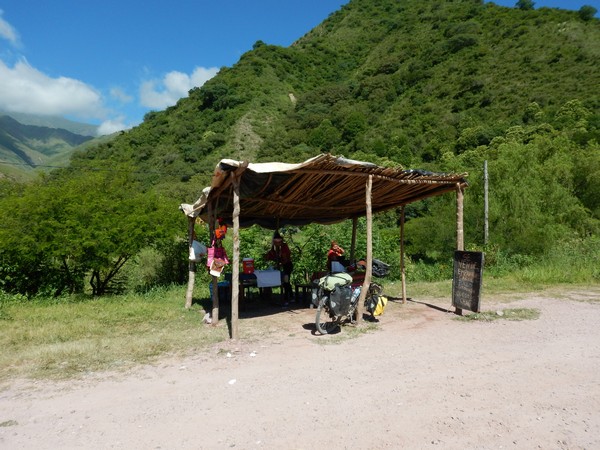
They cost between 15 and 20 pesos for 3 empanadas and are either baked or deep fried. Again, a great snack to keep you going when peckish.
The other thing that is nice about Argentina is that when you pass a village there is normally a sign at the turnoff telling you what tourist services there are:
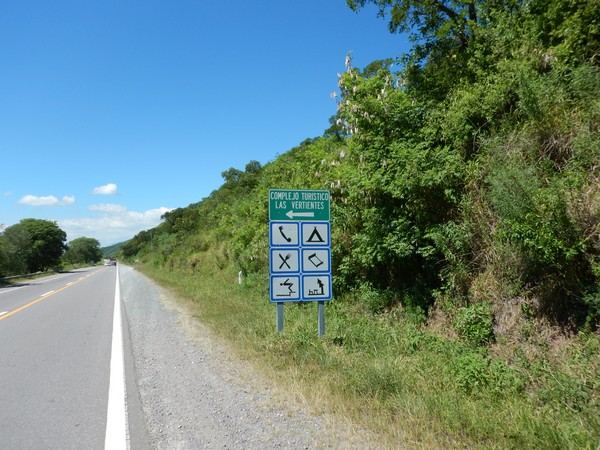
On most of the approaches to villages or towns they have installed central cones that are aimed at slowing down the traffic

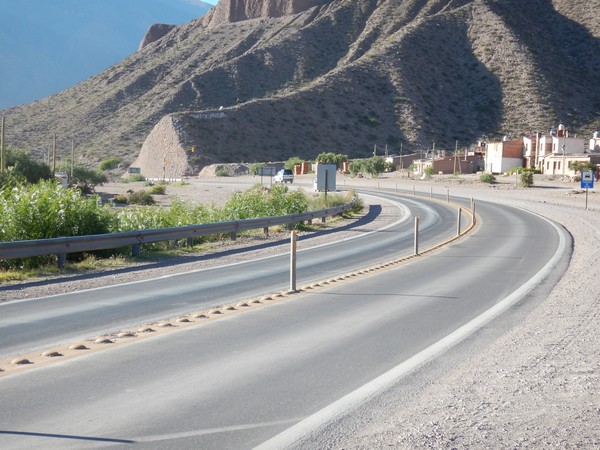
This makes the lanes very narrow and so very difficult for cars, buses and trucks to try to overtake me. Sometimes there is a gravel area next to the road that I can pull over to to let vehicles past but when there is not, so far anyway, vehicles have just stayed behind me rather than trying to squeeze through. It seems like drivers in Argentina are a fairly relaxed bunch.
I also probably get the most waves out of any country that I have travelled through and whenever I stop people always come over to have a chat about what I am doing.
It seems that horses and Gaucho’s, cowboys, are not just part of folklore here they are part of the tradition of the country and all day I passed a stream of riders on horseback whether it was out in the country or in the towns I passed through
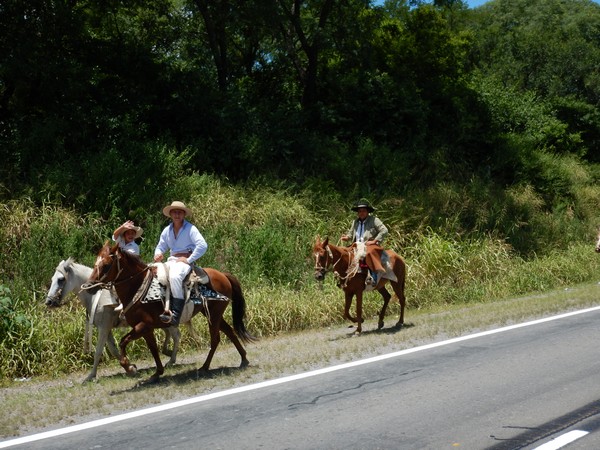
The road that I had been following since crossing the border into Argentina was Route 9 and as I arrived at the outskirts of the city of San Salvador de Jujuy the road turned into the autopista, which was like riding down a motorway.
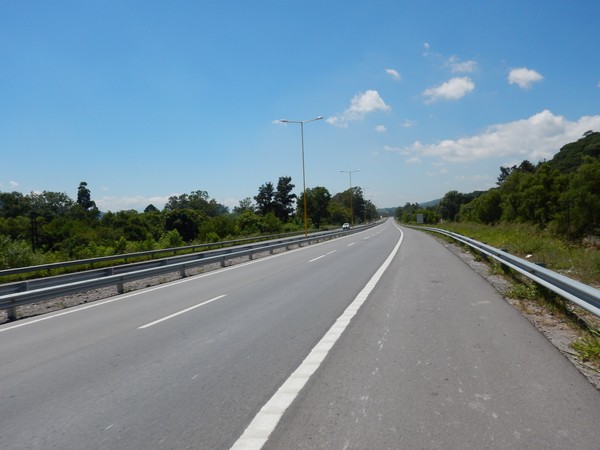
I checked the map and it seemed like there were two routes I could follow to reach Salta the first would be to stay on the autopista following the valley all the way to Salta, or I could head west and climb my way over a mountain ridge into the next valley and use that to reach Salta.
Climbing my way out to the next valley would be a much harder, and longer, route but it was preferable to riding for the next 100km or so down a motorway so I changed direction and headed west to El Carmen.
The road that I was now following was much quieter and there was even a cycle path for part of the way next to the road
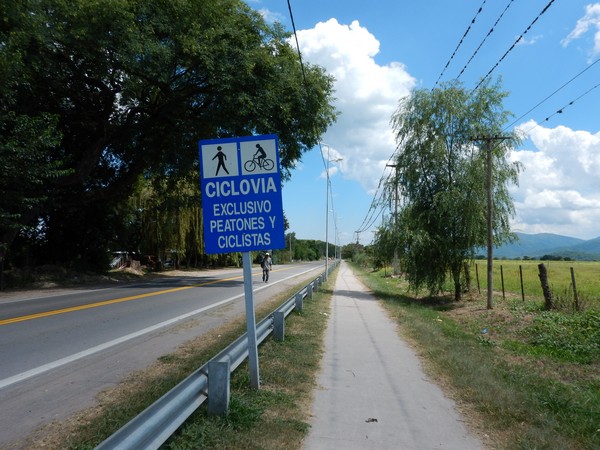
By early afternoon I had hit my 100km mark and so when I reached El Carmen I decided to call it a day. The town was really nice but once again as I had not only cycled into the town during siesta it was a Saturday and so apart from a couple of restaurants that were open everything was shut.
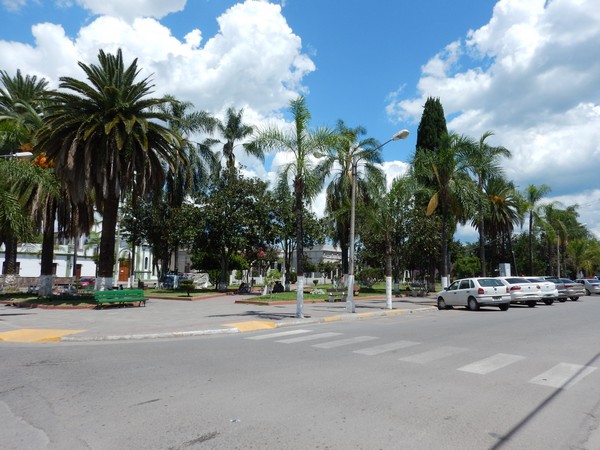
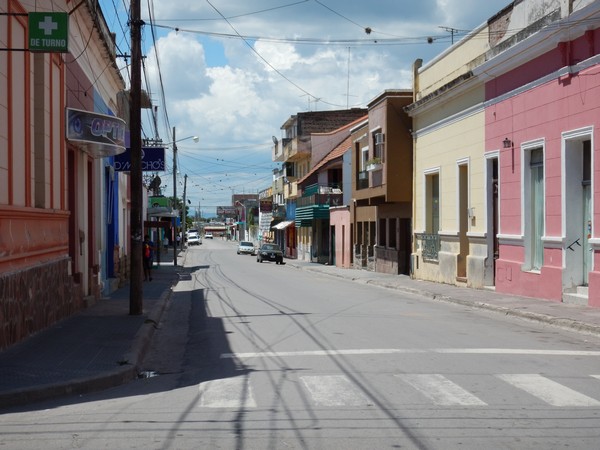
It seemed that the Gaucho’s were out in force though and I passed several groups of riders who were just stood around chatting.
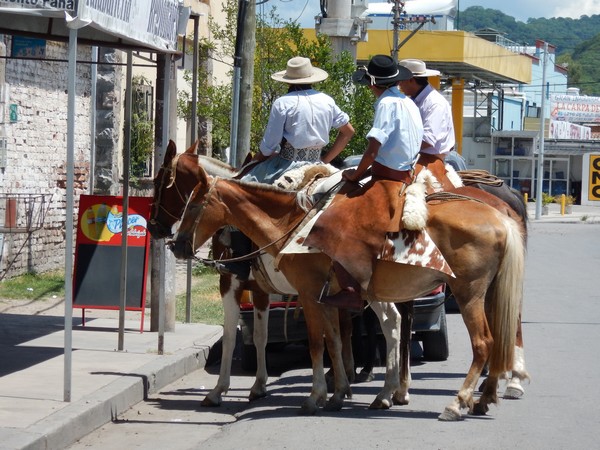
Most towns and cities in Argentina have municipal campsites and so I asked one of the locals where it was and she pointed me in the direction of a lake which lay about 3 kilometres from the centre.
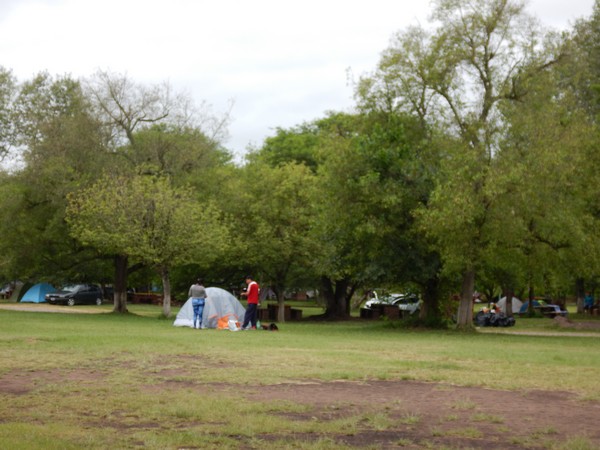
They had cycled up from Ushuaia which was the very tip of Argentina and were heading the way that I had just come from towards the Bolivian border. They told me that camping for Argentinians was a bit of an institution where they came en-mass, had a barbecue and then got drunk to very loud dance music on their car stereos. They said that as it was Saturday night that it would get very loud later on.
I decided that like the Dutch the best option was to camp at the entrance of the site rather than heading to join the masses that were concentrated near the back of the site
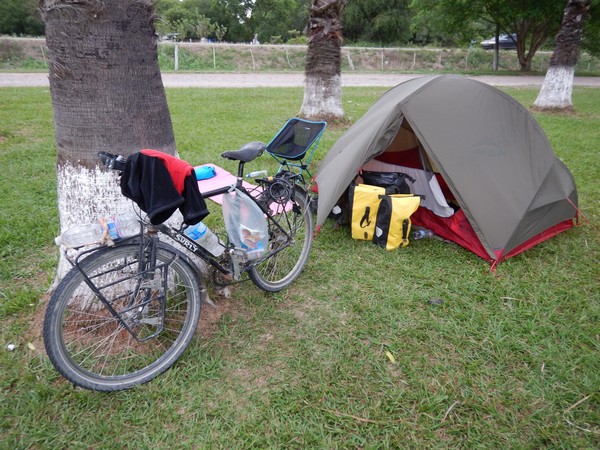
It was a very good choice as once darkness fell the dance music got going and when I went to bed around 11pm it was still going strong. The great thing about cycling +100km in a day is that I can sleep through anything and when I woke up at 4am to go for a pee there were loads of people still up and the music was going strong.
Perhaps, I should have joined them for the true Argentinian experience but instead I headed back to my sleeping bag for another few hours of sleep and left them to it.
I’m not sure if the Dutch cyclists had slept aswell as I did though as when I got up around 8am they had already packed up and left. Or maybe they were just early risers which is something that I was still struggling with on this trip.
My plan to get going early in the day to beat the wind didn’t seem to last long as by the time I had had breakfast, packed up the tent and then had one last coffee it was nearly 11am. Still, as it looked like I would spend the first few hours climbing my way through a forest over into the next valley the trees should shelter me from the worst of the wind.
After nearly a month of climbing bare rock mountains in the Bolivian altiplano and the Argentinian puna that day when I set off into the forest was like cycling in a different country. There were birds chirping in the trees and cows grazing next to the road
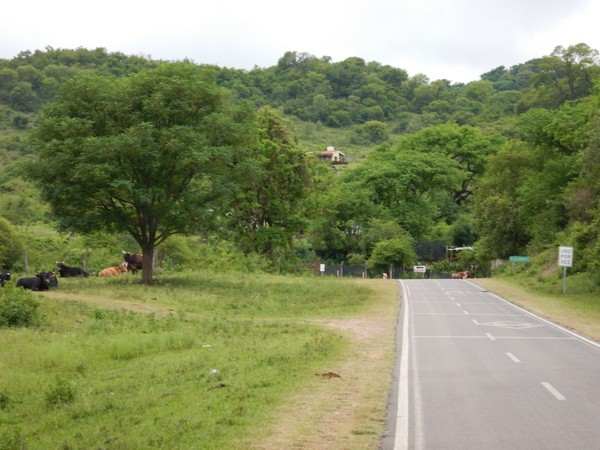
As I climbed higher through the trees into the clouds the smells were amazing and the views back down the valley were great
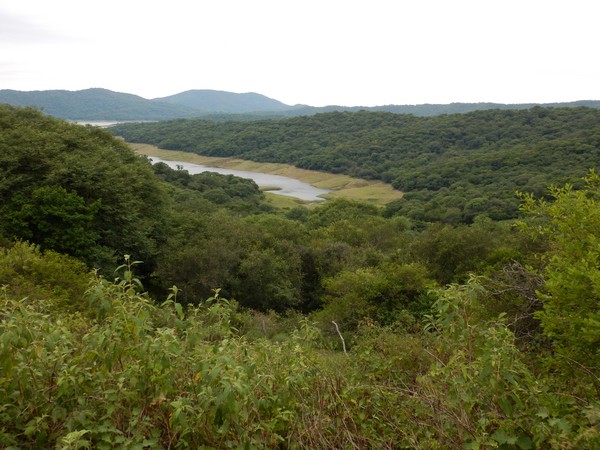
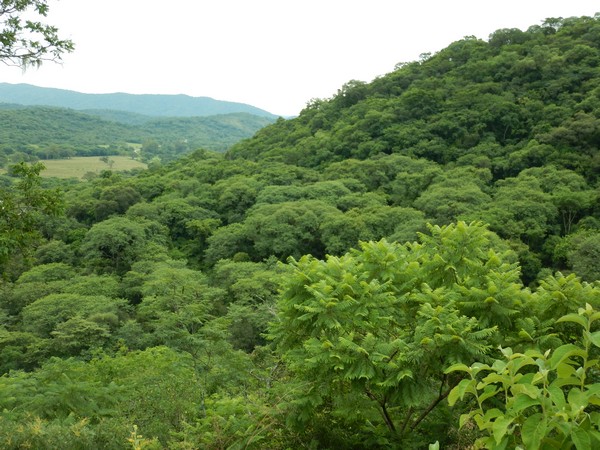
The road continued to climb for the next couple of hours
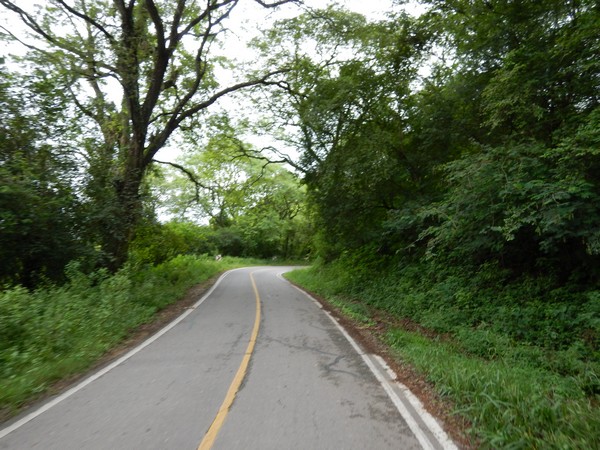
At the top of the pass was the village of Alto La Sierra where there was a flat area that had a lovely view back down the valley that I had just climbed out of.
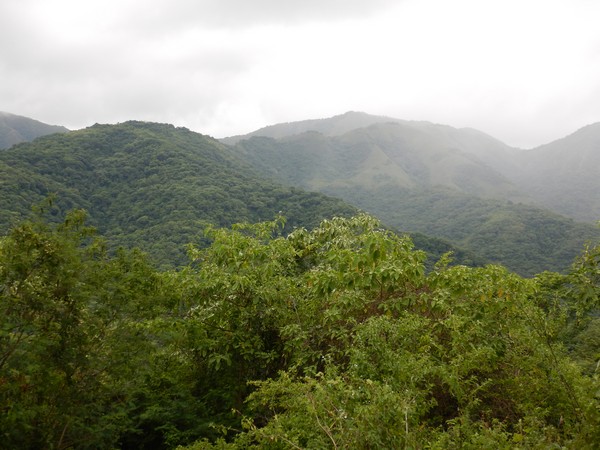
I could have camped for the night but as I had only cycled around 30km I decided that it was best to push on.
Once over the top there was around 20km of descent before I reached the town of La Caldera which the Dutch cyclists that I had met the night before had told me had campsites or if I got there early made a great place for a lunch stop.
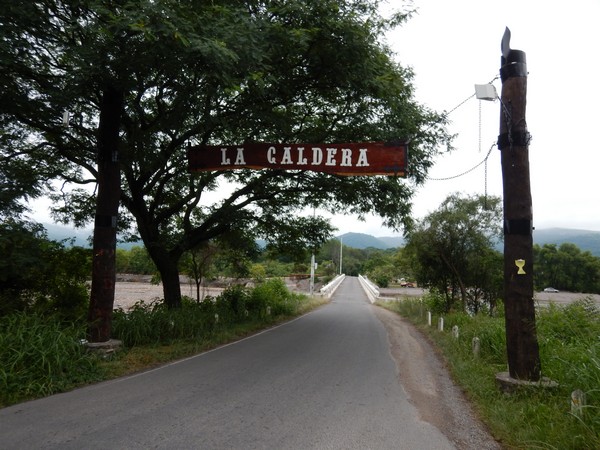
As it was a Sunday the Asado chefs seemed to be out in force and all along the main street there were rows of people selling grilled food.
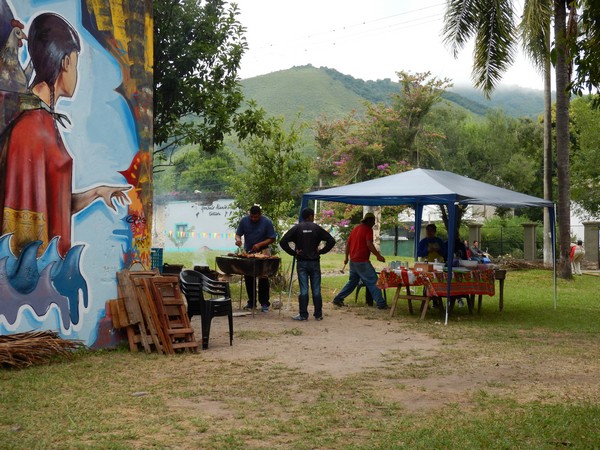
Each one had a few tables set up in the shade of trees
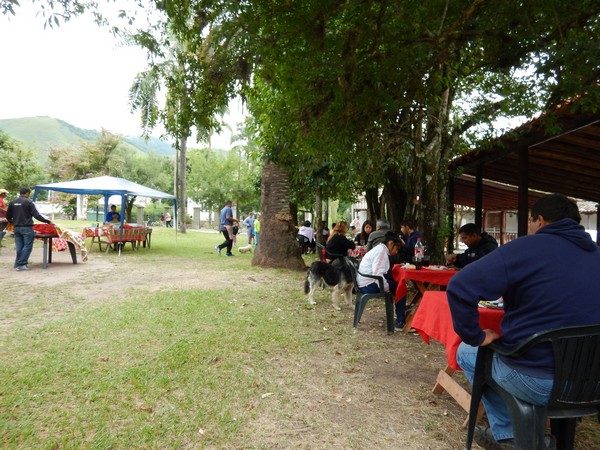
and for around 100 peso (5 GBP) you got a plate of meat with potatoes
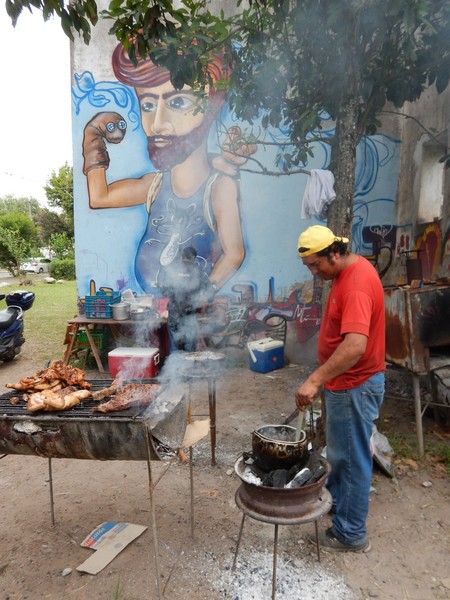
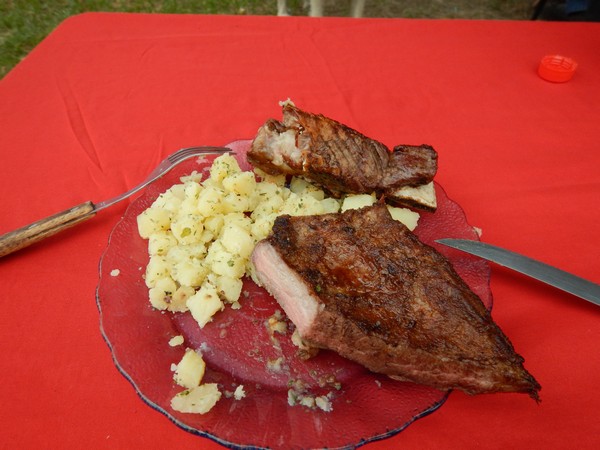 As it was still early I decided to push onto Salta rather than spend the night in La Caldera as it was only another 30 km or so down the valley.
As it was still early I decided to push onto Salta rather than spend the night in La Caldera as it was only another 30 km or so down the valley.
On the outskirts of Salta there was a huge metal Armadillo sculpture that was on one of the roundabouts near the airport
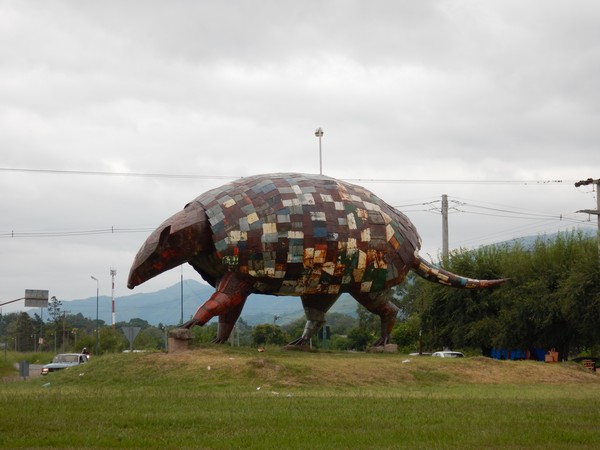
I headed through the centre of Salta towards Plaza 9th July which seemed to have a lot of hosteleria nearby. I went into about 5 or 6 and the standard of accommodation in Salta was pretty desperate. Most of the rooms I saw had no windows and were fairly dingy. After about 30 minutes of searching I found a great room at Hostal Inti Raymi with breakfast for 500 peso.
The area that I was staying was just up from Parque San Martin which had lots of eateries and people promenading at night time.
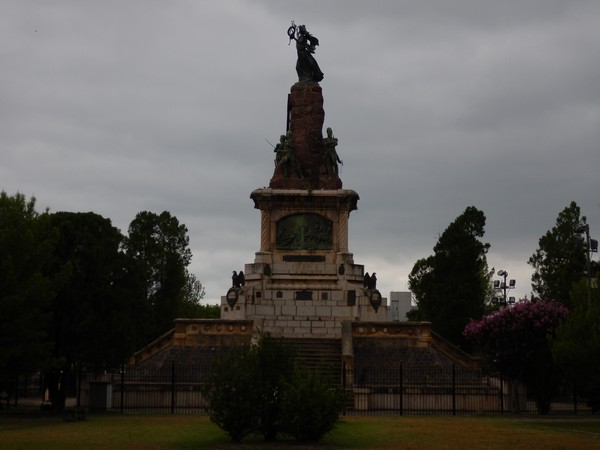
That evening I joined them for a promenade and dinner was a lomito (steak sandwich) washed down with a litre of beer.
The next day it was time to go and check out what sights Salta had to offer. First up was the teleferico which lay at the far end of Parc San Martin.
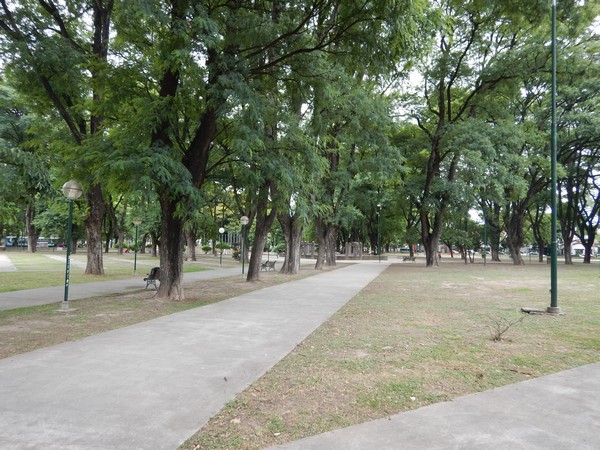
The teleferico was fairly expensive at 150 pesos but it would save me an hours hike up the mountain to the viewing tower at the top
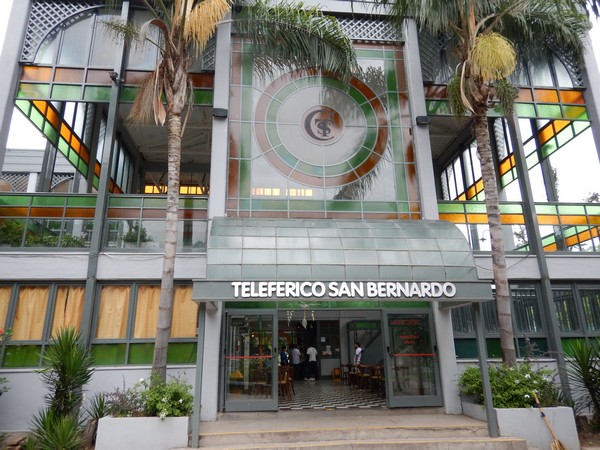
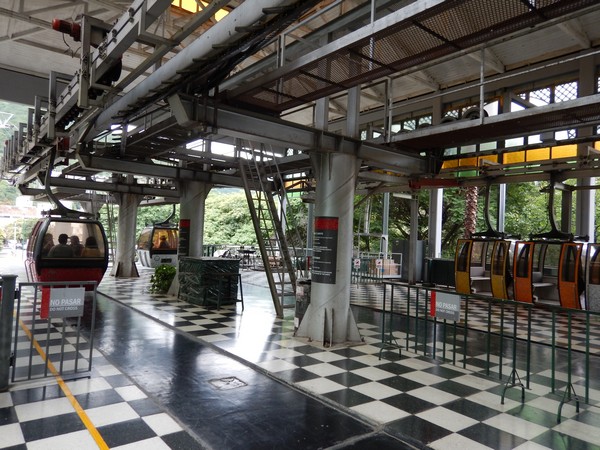
At the top there was a café and so I headed there for coffee to sit and enjoy the view over the city if Salta
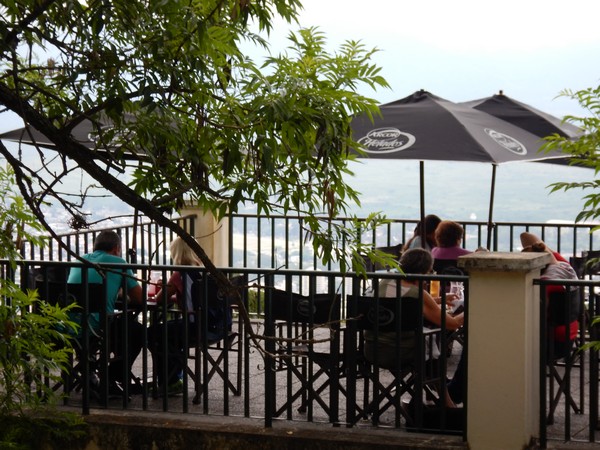
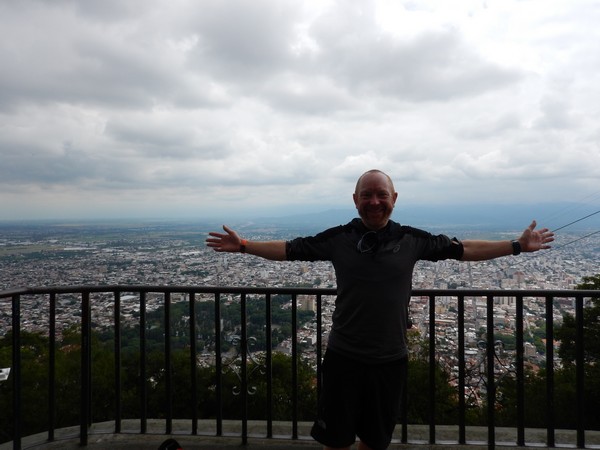
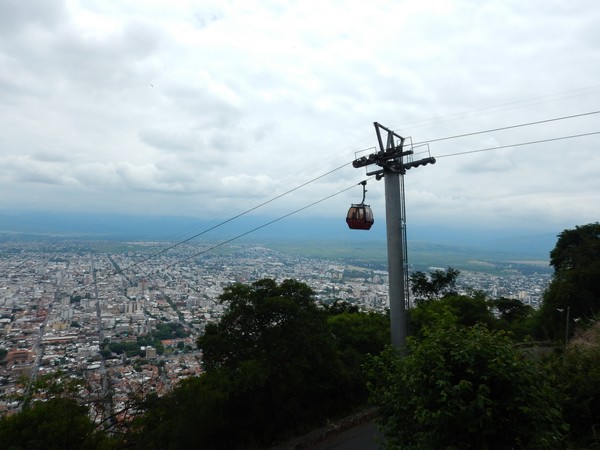
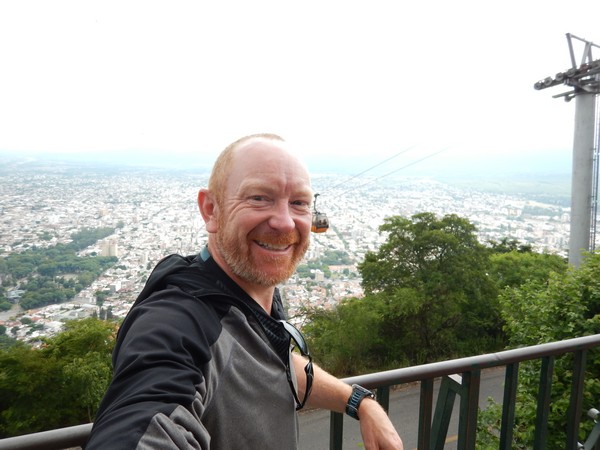
There was a sealed road upto the top and while I was enjoying the view a group of cyclists climbed their way to the top and I did feel that I should have joined them on the ride up rather than taking the cable car. I’m sure that the coffee would have tasted better if I had.
After enjoying the view it was time to head back down into the city to see what else there was on offer.
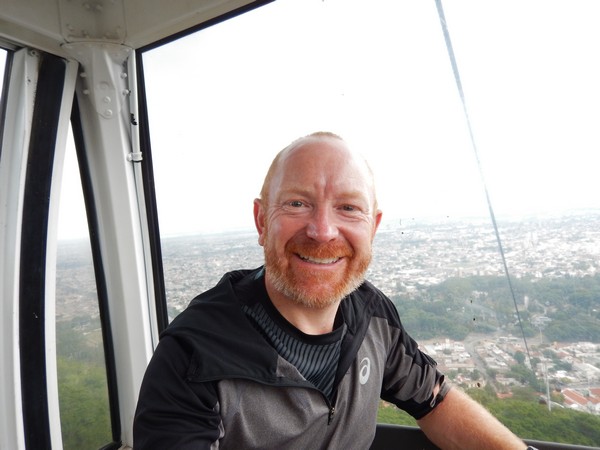
At the bottom of the teleferico there was a boating lake and the locals were busy rowing their way around the lake
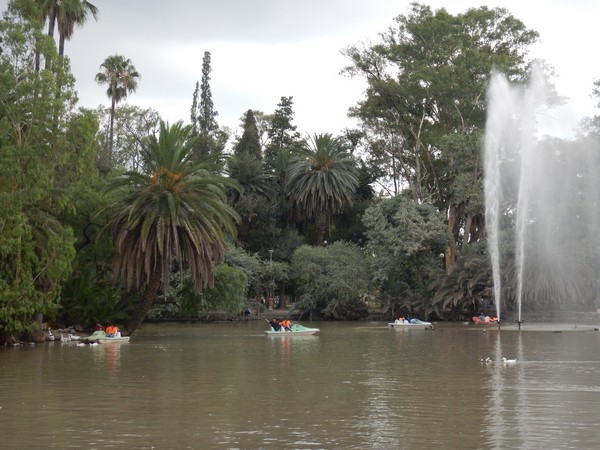
As Argentina is a catholic country churches featured heavily in the city and on my way back to the centre I stopped at Iglesia Saint Francis.
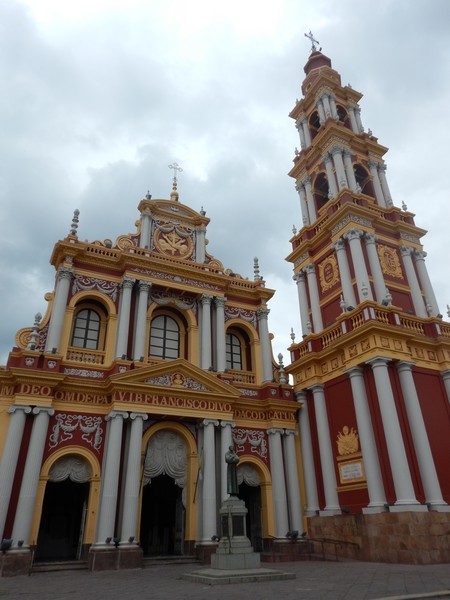
The church with it’s blood red coat of paint and prominent white pillars is one of Salta’s most famous landmarks. Its foundations date to 1582, the year that Hernando de Lerma founded the city, but a series of fires destroyed the original building.
The present structure was rebuilt in 1882 and the 50 metre belfry, the tallest in South America, houses a bell made from bronze cannons which were used in the Argentine War of Independence.
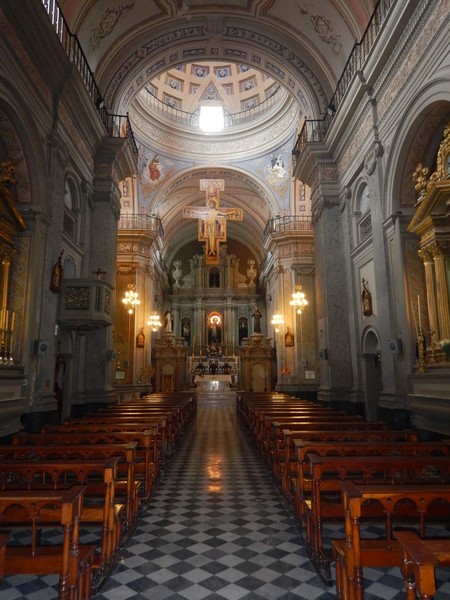
Like many cities in Argentina the architecture is heavily influenced by the Spanish Colonisation. Salta has conserved most of it’s colonial architecture and is a beautiful city to wander through the many plazas with their cobbled streets and parks.
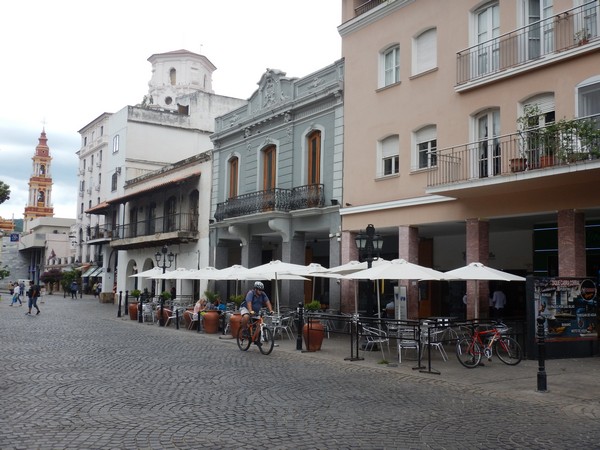
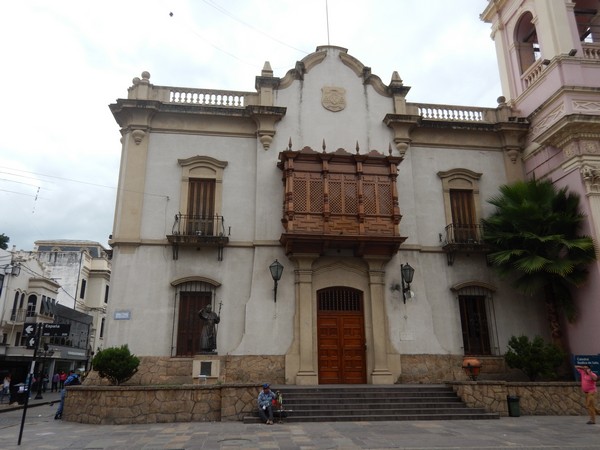
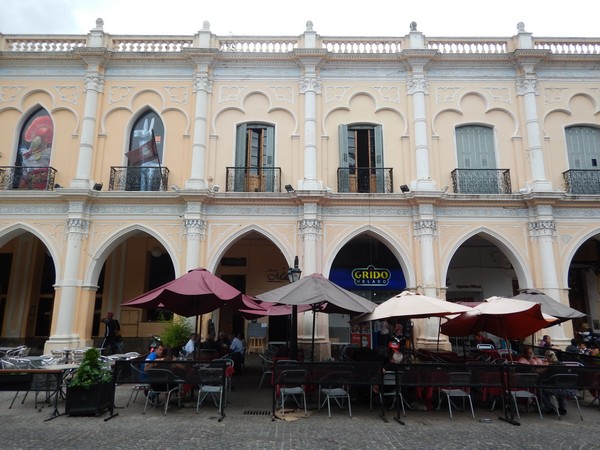
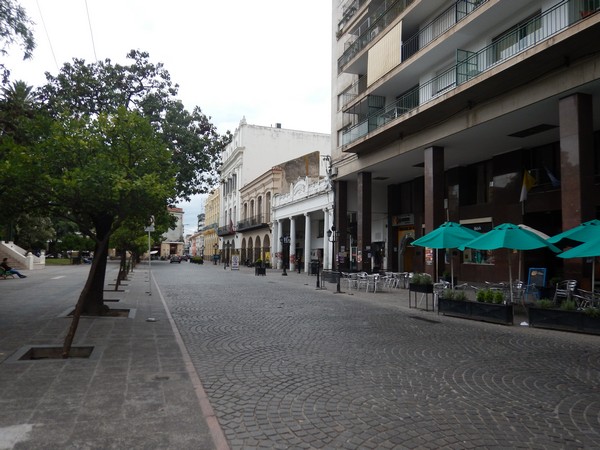
In the evening I joined the locals as they headed for mass at the Catedral Basilica de Salta which is the most important church in the city and is located on the northern end of the main plaza.
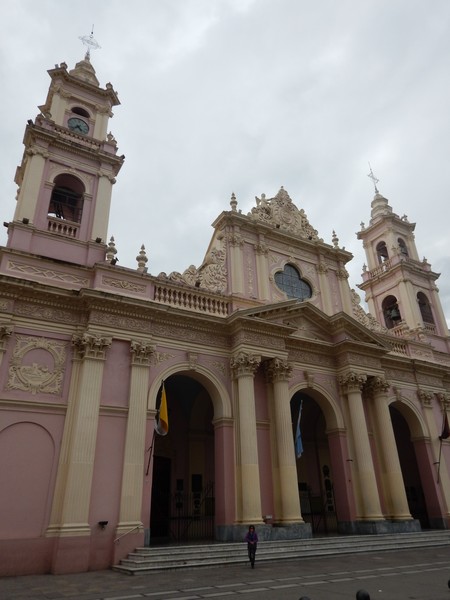
There must have been in excess of 1000 people at mass and there was standing room only.
I was only going to be spending two nights in Salta but one of the museums that I wanted to go to wasn’t open on a Monday and so I would stay an extra day and enjoy what the city had to offer.
The museum that I wanted to visit was the Museo de Arqueología de Alta Montaña de Salta. The museum is dedicated to the mummified bodies of three Inca children who were discovered entombed beneath rocks at the top of the 22,000ft high Mount Llullaillaco by Dr. Johan Reinhard and his archaeological team on 16 March 1999.
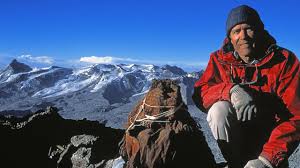
Collectively they are known as the Children of Llullaillaco and one of them is always on display at the museum at any one time. Thanks to the bacteria busting qualities of the 22,000 ft high altitude mountain air the children are considered to be the best preserved mummies in the world.
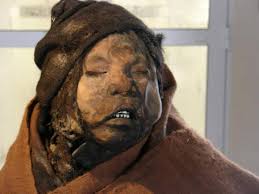
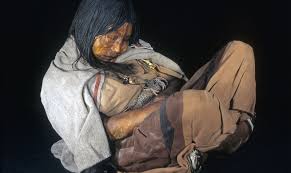
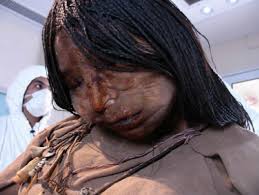
The eldest child, called the Maiden, is believed to have been 15 years old when she died of cold on the mountain top (it is believed that they were all entombed while still alive). The other two, a boy known as El Nino and a girl called the Lightning Girl, because her body is believed to have been struck by lightning sometime after her death, were aged about 7 and 6 years old respectively.
To preserve them at the museum they are kept cryogenically refrigerated, even when on display, and the level to which these children are preserved is amazing, with the bodies being completely intact with all their original hair, teeth and skin, and apparently their last meal still undigested in their stomachs.
When I visited the museum the child on display was ‘The Lightning Girl’, whose face seemed frozen in agony. The clothes she wore are estimated to be over 500 years old but the colours are as fresh as if they were made yesterday
Archaeologists believe that these children were carefully selected for their beauty and perfection, from the highest stratum of Inca society, chosen to serve as sacrificial offerings to the Gods in a ceremony known as a Capacocha.
Human sacrifice in Inca society was not common with animal and object offerings far more routine. Human sacrifices were special and done in times of crisis or acute need. The victims high social standing was proof they were the best the society of the time had to offer as there would be no skimping to appease the Gods in critical times.
These kinds of child sacrifices were likely done when an old ruler had died and a new one came to power, or in times of severe drought or natural disaster, times when blessings from the Gods would be especially needed.
The story of the Llullaillaco Children’s final days is extraordinary. Before being sacrificed they were taken in grand procession from their home town, across the kingdom to the Inca capitol of Cuzco where they were presented to the Emperor and celebrated with feasts and great public ceremony.
Then the children and their ceremonial entourage continued their journey, on foot, from Cuzco to the chosen place of their sacrifice. In this case it was hundreds of miles away and the whole tour is thought to have taken about a year to complete.
In Inca society, to be selected was considered a great honour, a privilege that would transform those chosen into Gods, enabling them to watch over their people for eternity. For the families of these children, and some gladly offered them up, it was also a prestigious act securing them an elevated place in society.
Upon reaching the mountain top they would be drugged up on a corn based alcoholic drink called Chicha. This would have a calming effect and was probably designed to put them to sleep before the entombment began. They were sealed in the tomb along with some beautifully crafted trinkets and talismans, and left to die of cold. One can only imagine the horror of waking up, inebriated and freezing to death, alone in the darkness of such a tomb.
There is an ongoing controversy in Argentina about whether the children should be on display at the museum with many people feeling that their removal from the summit of the mountain a desecration and demand the children be returned to their original resting place. The Museum quite reasonably argues that now that the site of the tomb is known, if the children were returned to it, they would be stolen.
Whatever the specific details of their death and ongoing controversy, the museums atmospheric exhibit of the children and their ceremonial trappings was worth spending the extra day in Salta and you should definitely add the museum to your itinerary if you are ever in Salta.
I had spent a great couple of days wandering around Salta and now that I had been cycling in Argentina for about a week I decided to celebrate with a final meal of Bife de Chorizo (which has nothing to do with sausage by the way)
Argentinians take their steak eating very seriously and there are 5 main cuts of meat that they eat. In descending order the best cuts are considered to be:
#5 – Bife de lomo (tenderloin)
This is the cut that is mostly served in a parrilla. It tends to be the most expensive cut, and it’s tender and juicy. However, in Argentina it is described as being like ‘a beautiful model’ – nice to look at, but nothing under the surface’ because it’s flavour can sometimes be not particularly thrilling. (this is not my analogy by the way!!!!)
#4: Entraña (skirt steak)
A favorite among Argentineans, it’s a thin cut of meat but very flavorful. It’s not as tender as other cuts and the saying goes that if you order it, be prepared to use your jaw a little.
#3: Asado de tira (short ribs)
The way they serve ribs in Argentina is different from most other places in the world as they are cut very short which means that some of the pieces may not have a lot of meat on them. However, they have a lot of flavor and are usually deliciously crispy, and they’re also very cheap.
#2:Vacío (flank steak)
This is again an Argentinian specialty that is a thin cut of meat from the flank of the cow that’s characterized by a layer of fat on the outside but none on the inside. If cooked properly the exterior fat gets crisp and the inside beautifully tender and juicy.
#1: Bife de chorizo (sirloin / New York strip)
This for many people is the cut of beef to beat all other cuts and exactly what a steak should be: big; juicy; with some tasty exterior fat; literally dripping with flavor. It also has a reputation for getting what you pay for and so if you order it at a cheap restaurant you’ll generally get a cheap cut, and cheap cuts of Bife de Chorizo can be very fatty indeed.
I ordered my Bife de chorizo completo which meant that it came with two fried eggs, chips and salad.
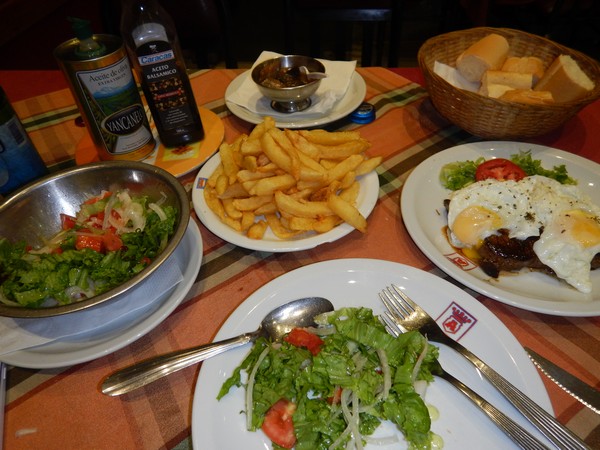
It really was too much food for one person but for 250 pesos (12 GBP) I had a feast and it was a fitting end to the first leg of my cycle ride through Argentina.
If you would like to automatically receive all future posts straight to your email inbox please just add your details to the form at the foot of this page.